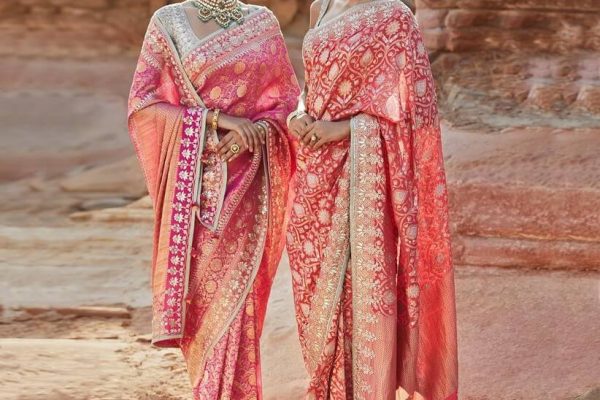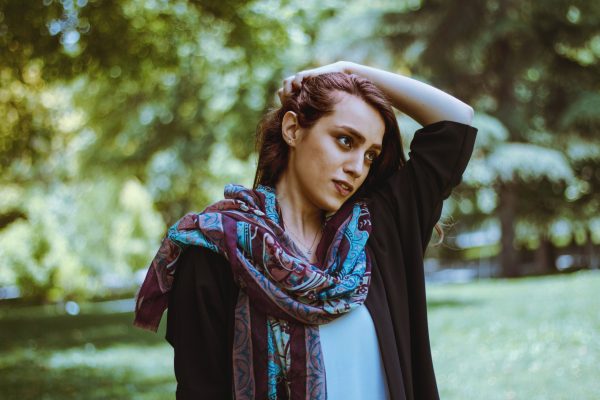The Indian wedding saree is a masterpiece that weaves together tradition, craftsmanship, and emotions. It serves as a canvas on which the bride’s journey from maidenhood to matrimony is painted. Each region of India boasts its unique style of wedding saree, reflecting the diversity and cultural richness of the country.
1. Banarasi Silk Wedding Saree
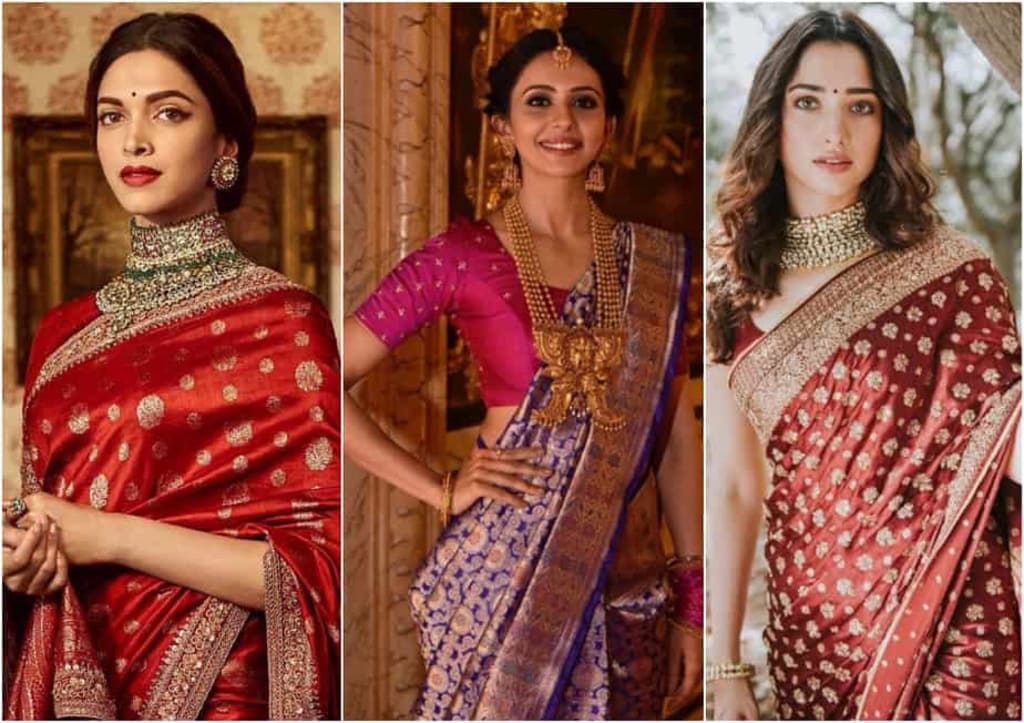
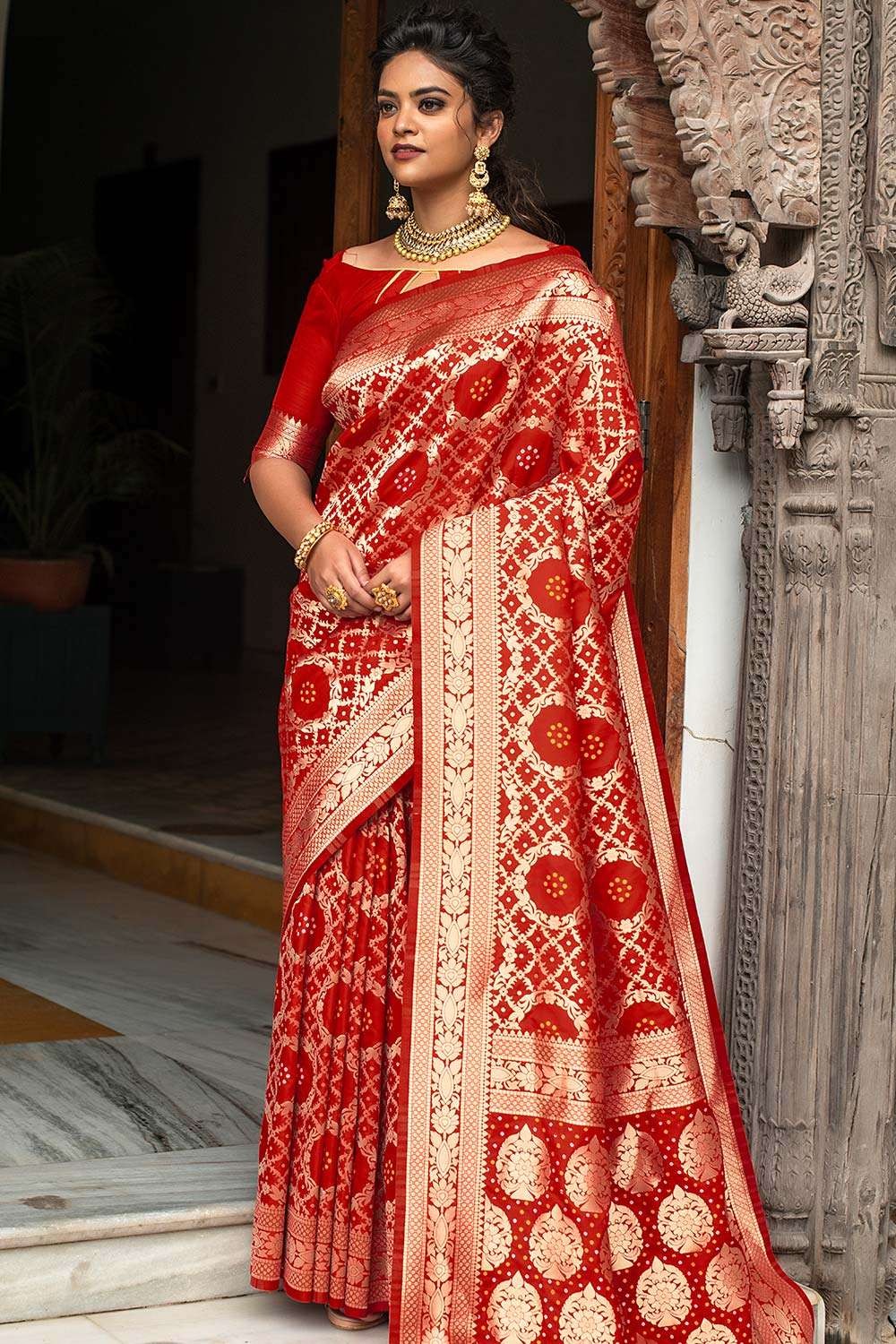
Banarasi Silk wedding Sarees are one of the most famous and revered types of sarees in India. They originate from Varanasi (formerly known as Banaras), a city in the northern Indian state of Uttar Pradesh. These sarees are known for their opulent and intricate designs, rich fabrics, and intricate weaving techniques. Here are some key details about Banarasi Silk Sarees:
Fabric and Weaving Technique: Banarasi Silk Sarees are made from pure silk threads. The weaving technique used is known as “Brocade” or “Zari.” This involves weaving gold or silver metallic threads into the silk fabric, creating intricate patterns and designs. The zari work adds a touch of luxury and elegance to the saree.
Designs and Patterns: Banarasi Silk Sarees are characterized by their elaborate and detailed designs. The patterns often include intricate floral motifs, leaves, vines, and Mughal-inspired designs. Some common motifs include paisleys, birds, animals, and geometric shapes. The borders of the sarees are usually broad and heavily embellished.
Varieties: There are several varieties of Banarasi Silk Sarees, each with its unique features:
- Katan: This type of Banarasi silk is made from twisted silk threads and is considered the purest form.
- Organza (Kora): This variety features a sheer texture and is often used as the base for intricate zari work.
- Georgette: These sarees have a slightly textured surface and are adorned with elaborate zari and resham work.
- Shattir: These sarees have a more lightweight and translucent appearance.
Motifs: Banarasi Silk Sarees are known for a wide range of motifs, including traditional designs like the “Butidar” (small motifs all over the saree), “Jhallar” (diagonal patterns), and “Tanchoi” (intricate weaving technique).
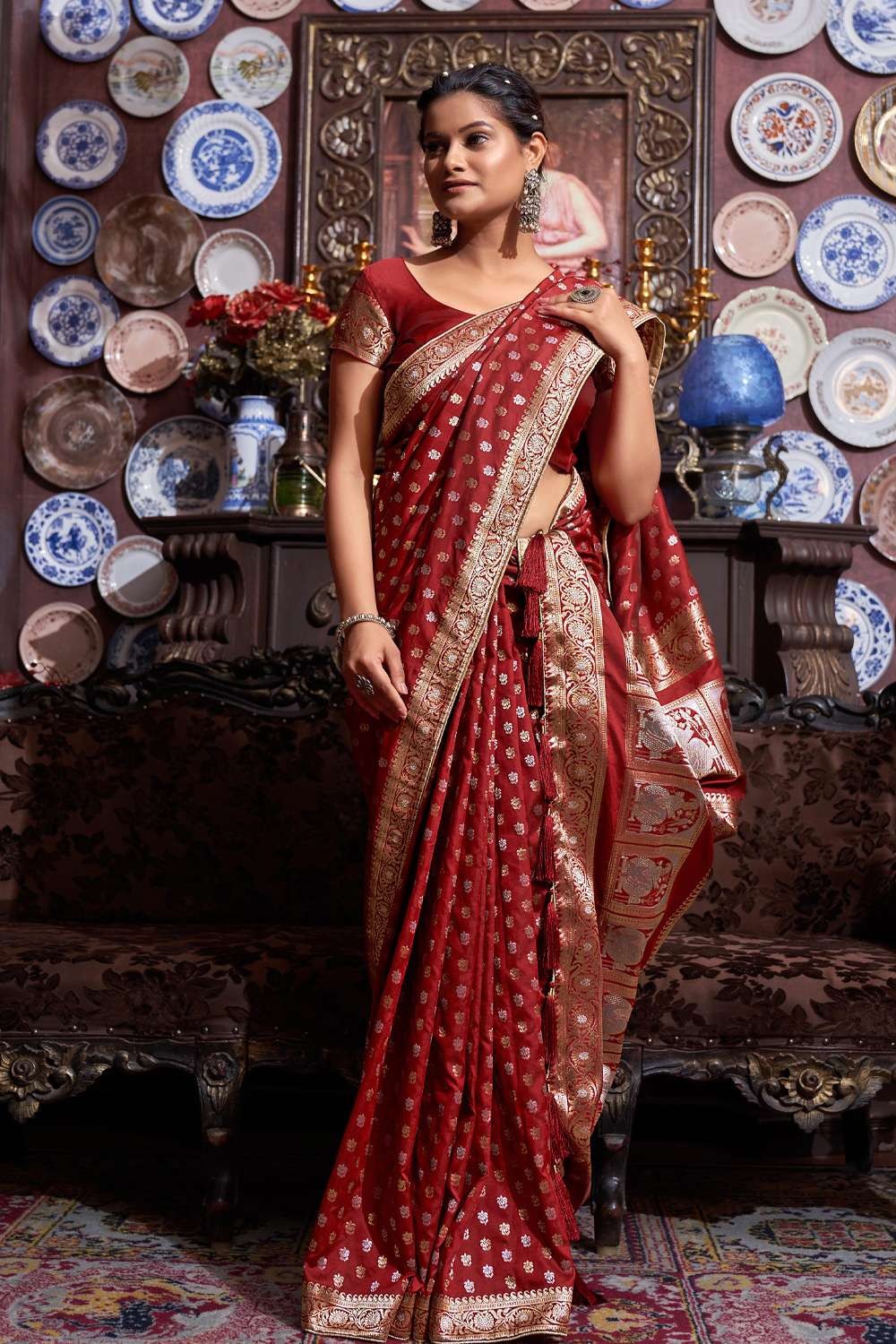
Color Palette: While traditional Banarasi Silk Sarees were predominantly available in rich gold, silver, and jewel tones, modern variations come in a wide array of colors to cater to contemporary tastes.
Price Range: The price of Banarasi Silk Sarees varies widely based on factors such as the type of silk, the intricacy of the design, and the craftsmanship. Pure silk sarees with heavy zari work are generally more expensive.
Maintenance: Due to the delicate zari work, Banarasi Silk Sarees require special care. They should be dry-cleaned and stored properly to maintain their sheen and quality.
- Cultural Significance: Banarasi Silk Sarees hold a special place in Indian culture and are often passed down as heirlooms from one generation to another. They are considered a symbol of elegance, luxury, and timeless beauty.
2. Kanjeevaram Silk Wedding sarees
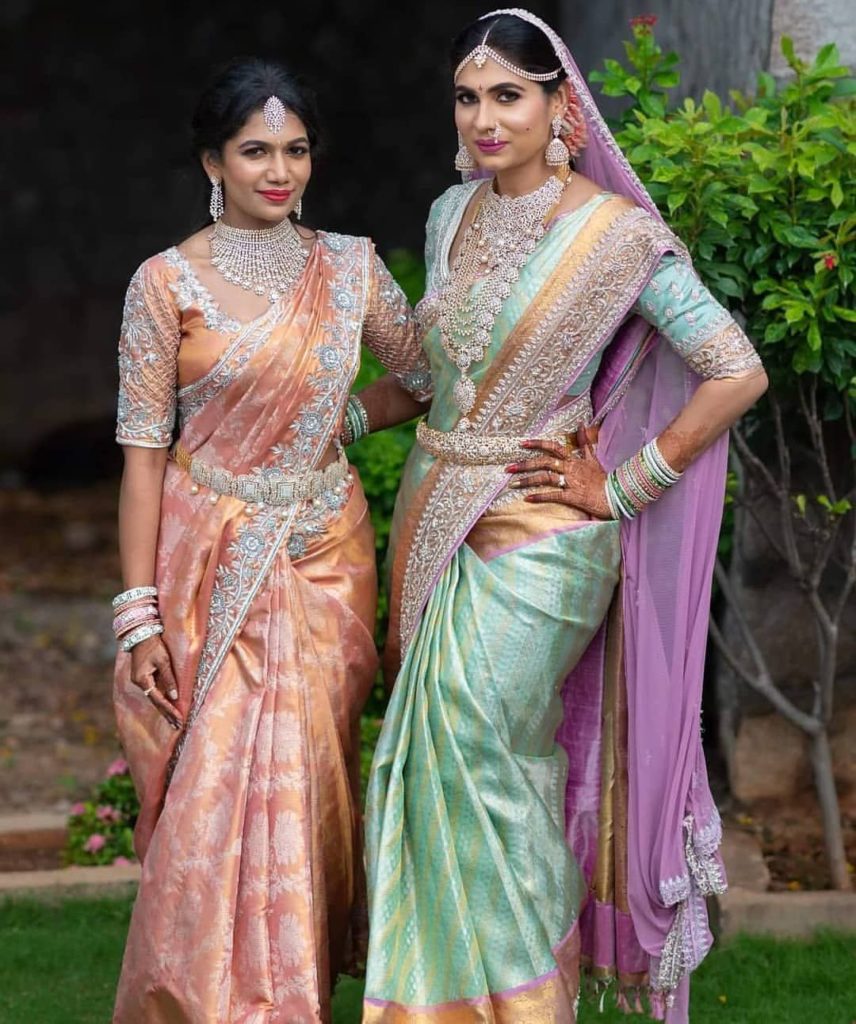
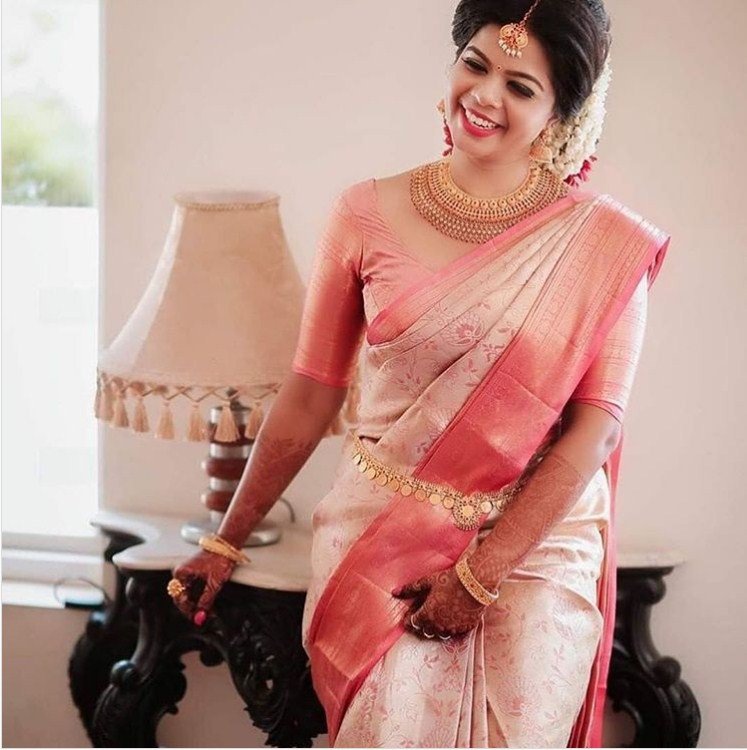
Kanjeevaram Silk Wedding sarees, also known as Kanchipuram sarees, are one of the most renowned and luxurious types of sarees in India. They originate from the town of Kanchipuram in Tamil Nadu and are celebrated for their exquisite craftsmanship, rich colors, and intricate designs. These sarees are highly sought after, especially for weddings and special occasions, due to their traditional beauty and cultural significance. Here are the key details about Kanjeevaram Silk wedding sarees:
Fabric and Weaving: Kanjeevaram sarees are crafted from high-quality silk threads, often combined with gold and silver zari (metallic thread) to create intricate patterns and designs. The weaving process involves traditional techniques that result in the saree’s distinctive texture and sheen.
Designs and Motifs: Kanjeevaram sarees are characterized by their bold and vibrant colors, contrast borders, and intricate motifs. These motifs often include temple designs, peacocks, elephants, flowers, checks, and traditional paisley patterns.
Color Palette: The color palette of Kanjeevaram sarees is rich and diverse, ranging from deep and regal tones like maroon, royal blue, and emerald green to more subtle shades like pastels and earthy tones.
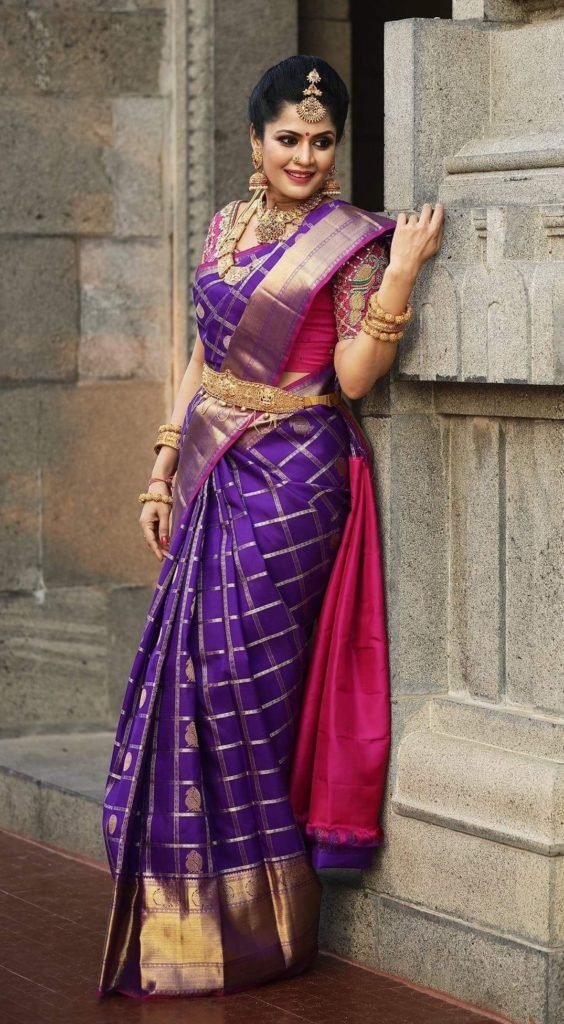
Pallu (End Border): The pallu of a Kanjeevaram saree is a significant part of its design, often featuring elaborate patterns and intricate detailing. The pallu may showcase large motifs, intricate borders, and zari work.
Border Design: The distinctive border of a Kanjeevaram saree, known as the “zari border,” contrasts with the body of the saree. It is usually wider and adorned with elaborate zari work, adding to the overall grandeur of the saree.
Texture and Feel: Kanjeevaram silk has a unique texture that is slightly thicker and sturdier than other silks. This gives the saree a luxurious drape and makes it ideal for grand occasions.
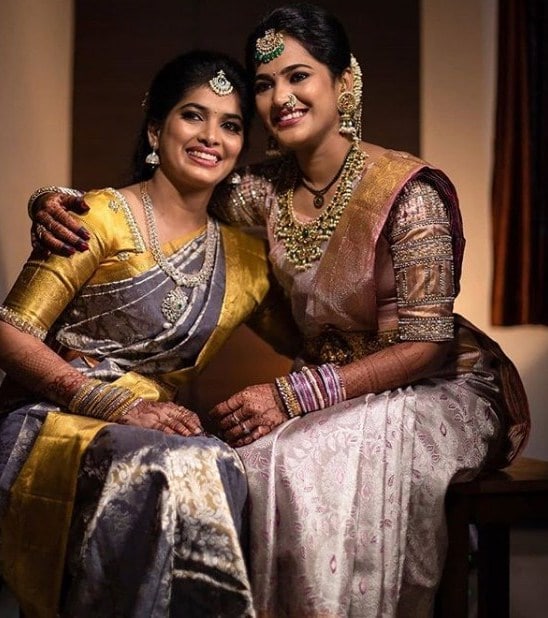
Authenticity and Markings: Authentic Kanjeevaram sarees bear a special marking or seal on the inner border of the saree, often indicating the authenticity of the handwoven product.
Maintenance: Due to their rich zari work and intricate designs, Kanjeevaram sarees require proper care. They should be dry-cleaned and stored in a way that prevents the zari from tarnishing.
Occasions: Kanjeevaram Silk sarees are highly coveted for weddings, festivals, and special occasions. They are often worn by brides as part of their wedding trousseau and hold cultural and traditional significance.
Symbolism: These sarees are considered a symbol of tradition, culture, and heritage. They hold a special place in South Indian weddings, and the bride wearing a Kanjeevaram saree is considered auspicious.
When searching for Kanjeevaram Silk sarees, it’s important to purchase from reputable and authentic sources to ensure you’re getting a genuine handwoven product. The intricate craftsmanship and timeless elegance of Kanjeevaram Silk sarees make them a treasured choice for brides and anyone looking for a truly special and luxurious outfit.
3. Paithani Wedding Saree
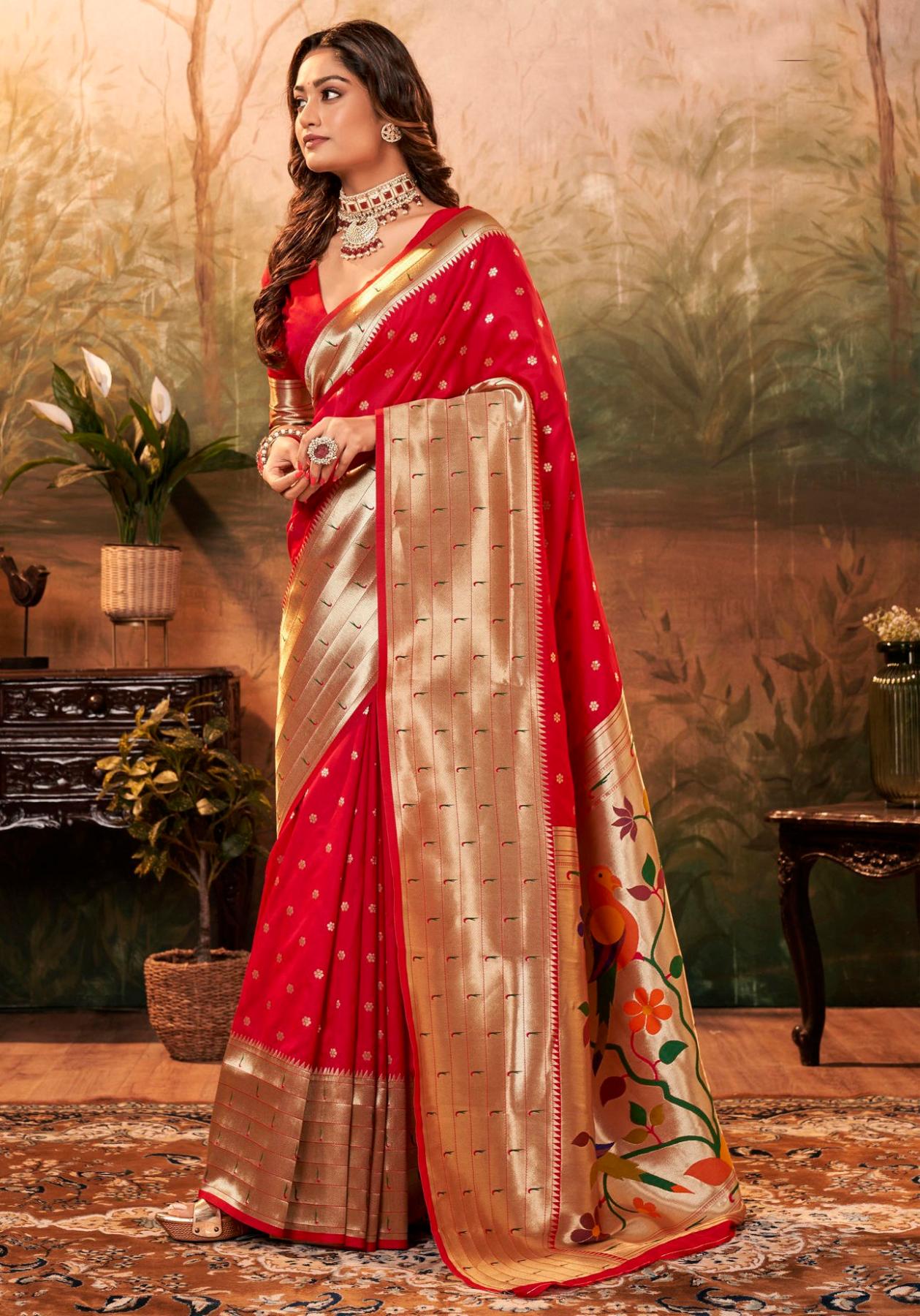

Paithani sarees are a type of silk saree that originate from Maharashtra, India. These sarees are renowned for their intricate designs, vibrant colors, and use of pure silk and zari (metallic thread) work. Paithani sarees hold a special place in Indian weddings, especially among Maharashtrian brides, due to their cultural significance and exquisite craftsmanship.
Here are some details about Paithani bridal sarees:
Origin: Paithani sarees take their name from the town of Paithan in Maharashtra, which is known for its rich history of weaving silk sarees.
Material: Traditional Paithani sarees are made from pure silk, which imparts a luxurious and rich texture to the fabric. They often incorporate zari work using gold or silver metallic threads, adding to their opulence.
Designs and Motifs: Paithani sarees are characterized by their intricate and elaborate designs. They typically feature intricate borders and pallus (the decorative end piece of the saree). The sarees are adorned with a variety of motifs such as peacocks, parrots, lotus flowers, vines, and more, all woven into the fabric using zari.
Color Palette: Paithani sarees are known for their vibrant and contrasting colors. The pallu and borders often showcase a different color than the body of the saree, creating a visually striking effect. Popular color combinations include green and purple, red and blue, and yellow and maroon.
Weaving Technique: Traditional Paithani sarees are woven using a technique called “tapestry weaving” or “weft technique.” This involves weaving the zari patterns along with the silk weft, creating a richly textured and detailed fabric.
Occasions: Paithani sarees are highly favored as bridal attire among Maharashtrian brides. They are considered a symbol of cultural heritage and are often passed down through generations as family heirlooms. Paithani sarees are worn not only during weddings but also on festive occasions and other important events.
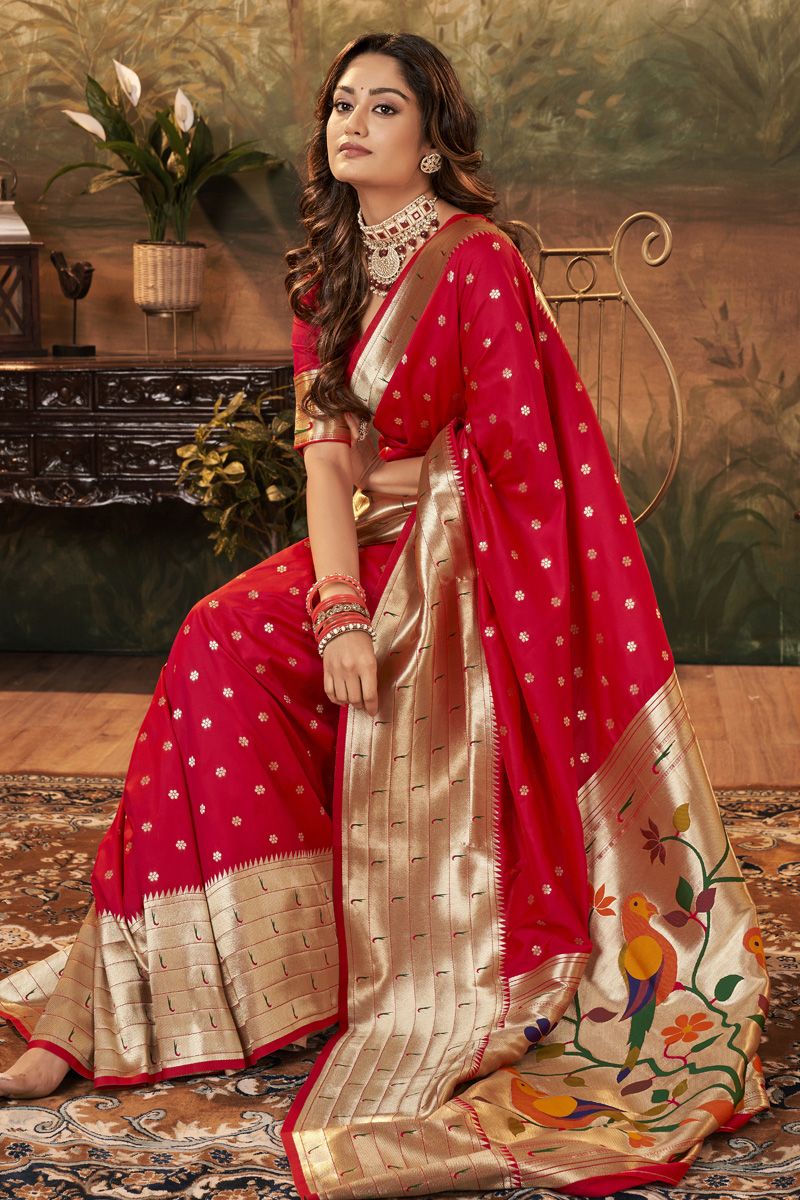
Price and Availability: Due to their intricate craftsmanship and use of premium materials, Paithani sarees tend to be relatively expensive. The price can vary based on factors such as the complexity of the design, quality of silk, and amount of zari work. These sarees can be found in specialized saree stores, especially in Maharashtra.
Care: Paithani sarees are delicate and should be handled with care. Dry cleaning is generally recommended to preserve the richness of the fabric and prevent damage to the zari work.
Overall, Paithani bridal sarees are treasured for their cultural significance, artistic beauty, and the sense of tradition they bring to Maharashtrian weddings. They continue to be an integral part of Indian bridal fashion and contribute to the timeless elegance of traditional weddings.
4. Bandhani wedding saree
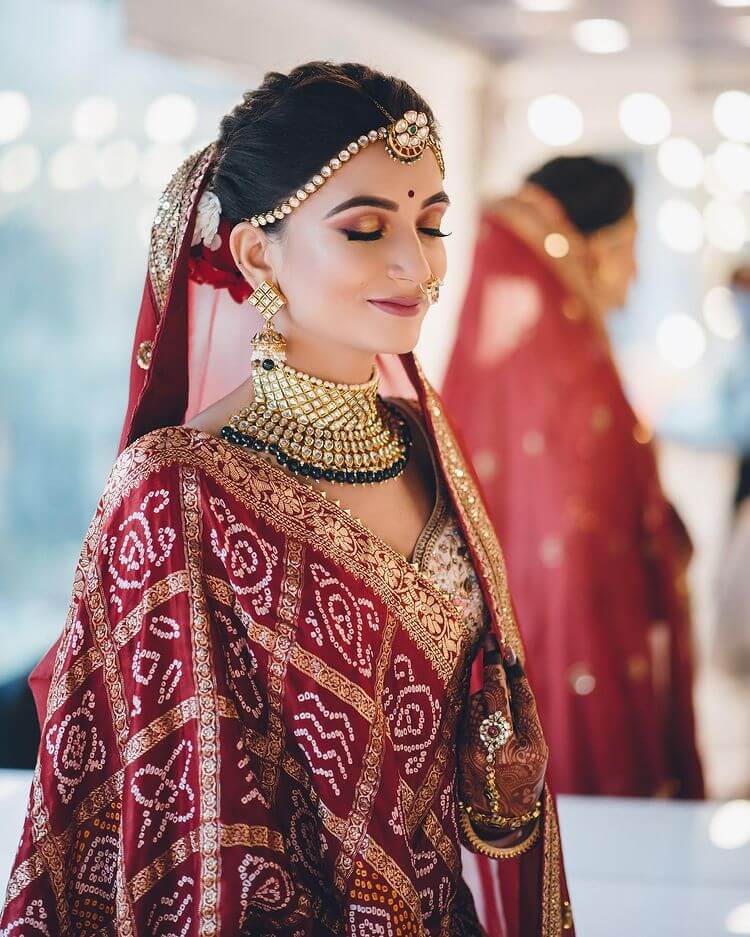

Bandhani sarees, also known as Bandhej or Bandhni sarees, are traditional Indian sarees that originate from the states of Rajasthan and Gujarat. These sarees are known for their vibrant colors and intricate tie-dye patterns, which are created by a unique and intricate dyeing technique. Bandhani sarees hold a special place in Indian weddings and festive occasions due to their rich cultural heritage and beautiful craftsmanship.
Here are some details about Bandhani wedding sarees:
Fabric: Bandhani sarees are typically made from lightweight fabrics such as silk, cotton, georgette, or chiffon. The lightweight nature of the fabric makes them comfortable to wear during warm weather and special occasions.
Dyeing Technique: The defining feature of Bandhani sarees is the tie-dye technique used to create intricate patterns. Small portions of the fabric are tied with threads in various patterns before dyeing. The tied portions resist the dye, creating the characteristic dots and patterns. The process requires great skill and precision.
Patterns: Bandhani sarees feature a variety of patterns, ranging from small dots (called “Binds”) to more intricate designs like waves, squares, and diagonal lines. The patterns can vary in size and density, resulting in a unique and beautiful visual texture.
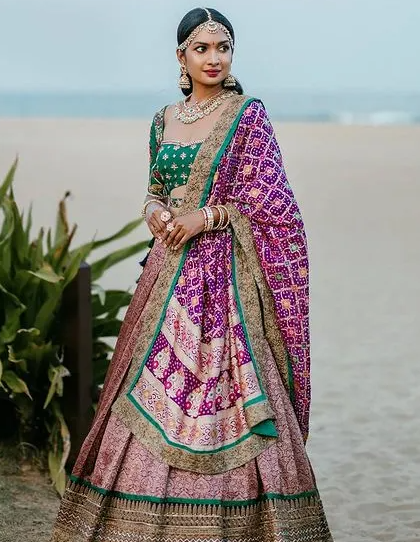
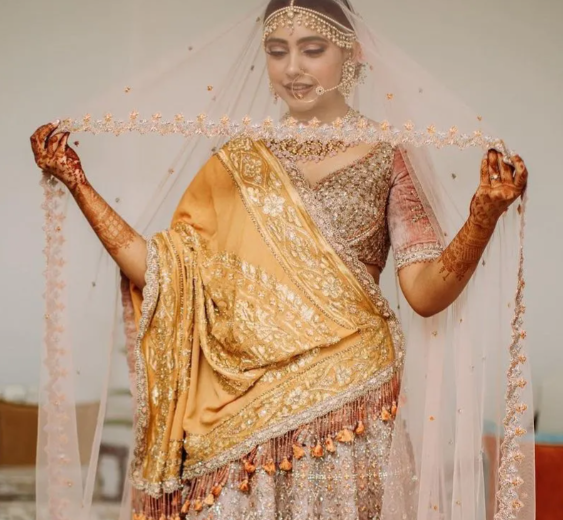
Colors: Bandhani sarees are known for their vibrant and bold color combinations. Bright shades like red, green, blue, yellow, and pink are commonly used. These colors are often combined to create stunning contrasts and combinations.
Occasions: Bandhani sarees are popular choices for weddings, festivals, and other special occasions in the states of Rajasthan and Gujarat. They are often worn by brides and other women during wedding ceremonies and celebrations.
Accessories: Bandhani sarees are often paired with traditional jewelry, such as heavy necklaces, earrings, and bangles, to complete the ethnic look. The choice of accessories can enhance the overall appearance and complement the saree’s colors.
Regional Variations: Bandhani sarees vary in style and patterns based on the regions they come from. For example, Bandhani sarees from Rajasthan might have larger dots and more vibrant colors, while those from Gujarat might have finer patterns and more subtle shades.
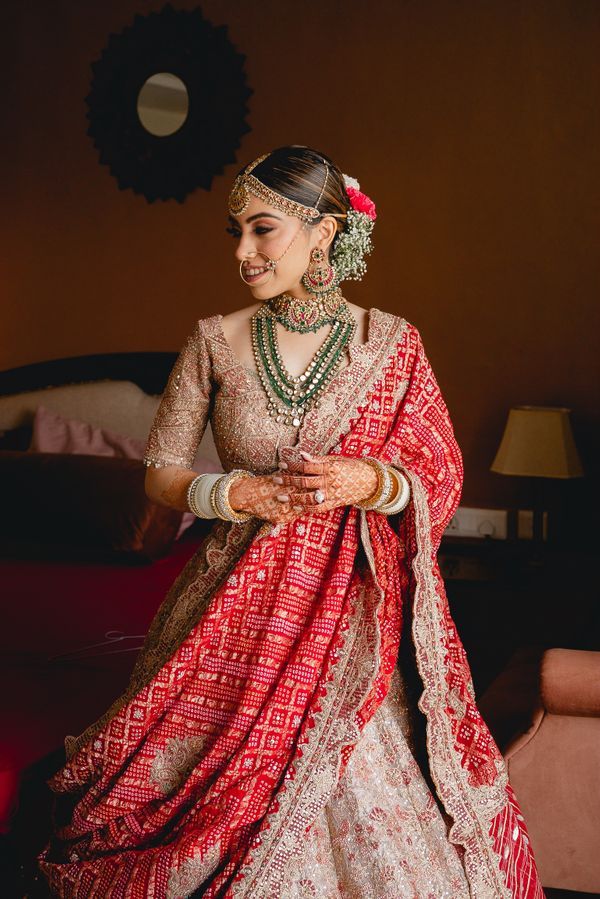
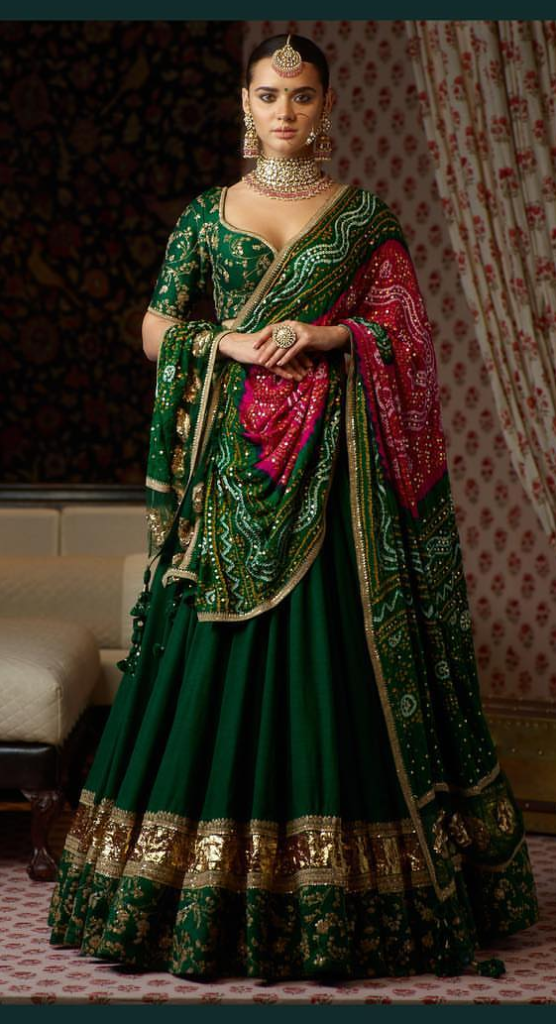
Availability: Bandhani sarees are widely available in ethnic fashion stores, online marketplaces, and specialized boutiques. They come in a range of price points, depending on the intricacy of the design, quality of fabric, and craftsmanship.
Maintenance: Bandhani sarees should be handled with care to preserve their tie-dye patterns and colors. Dry cleaning is often recommended to avoid damaging the delicate fabric and dye.
Overall, Bandhani wedding sarees are cherished for their cultural significance, artistic beauty, and the vibrant elegance they bring to any special occasion.
5. Patola wedding saree
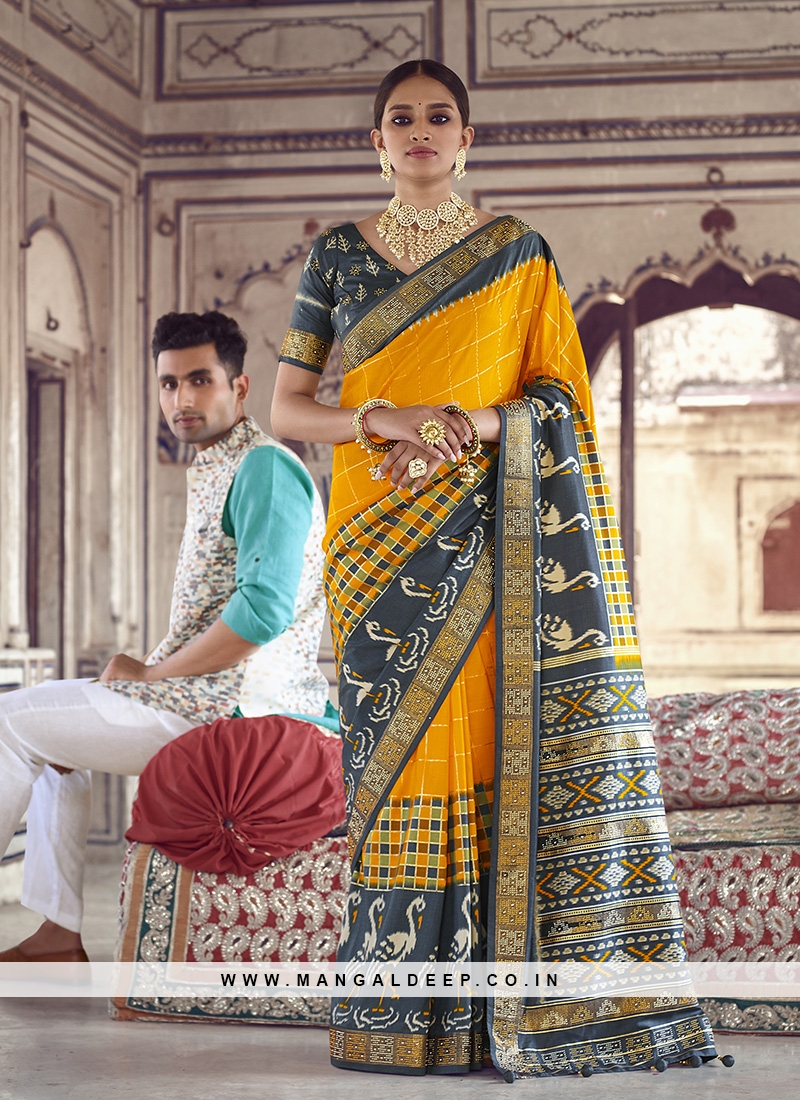
Patola sarees are one of the most exquisite and sought-after traditional Indian sarees, known for their intricate double ikat weaving technique. Originating in the Patan region of Gujarat, India, these sarees are renowned for their vibrant colors, intricate patterns, and rich cultural heritage. Patola sarees are often chosen for weddings and special occasions due to their luxurious appearance and fine craftsmanship. Here are the key details about Patola wedding sarees:
1. Ikat Weaving Technique: Patola sarees are unique because they are crafted using a complex double ikat weaving technique. This involves the precise tying and dyeing of both the warp and weft threads before weaving, resulting in intricate geometric and floral patterns.
2. Intricate Designs: Patola sarees are known for their elaborate designs, which can include geometrical shapes, animals, birds, flowers, and traditional motifs. The intricate patterns are meticulously created through the weaving process.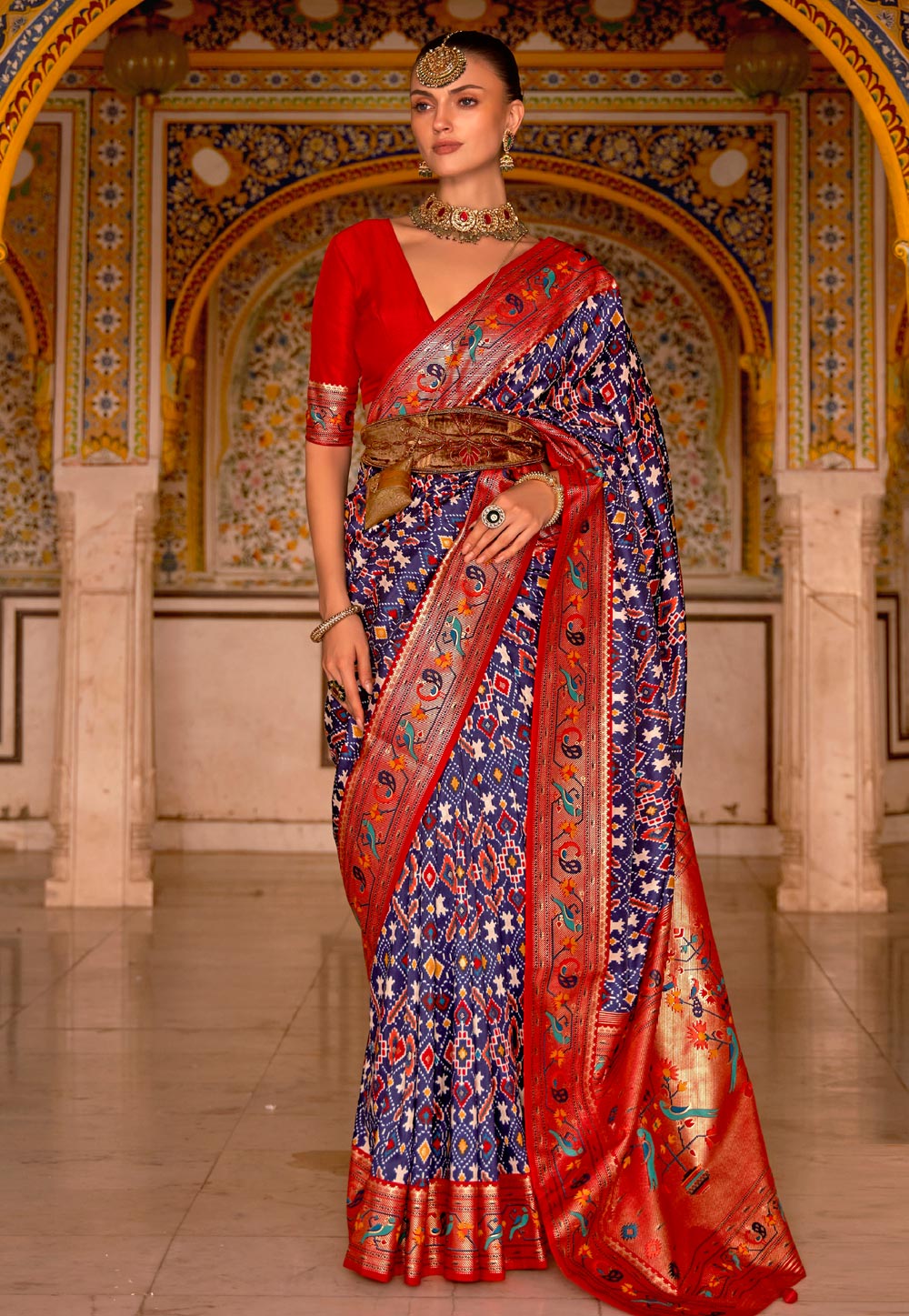
3. Rich Colors: Vibrant and bold colors are a hallmark of Patola sarees. The dyeing process involves using natural dyes to achieve shades like deep red, green, blue, yellow, and more. The colorfastness of Patola sarees is exceptional, adding to their appeal.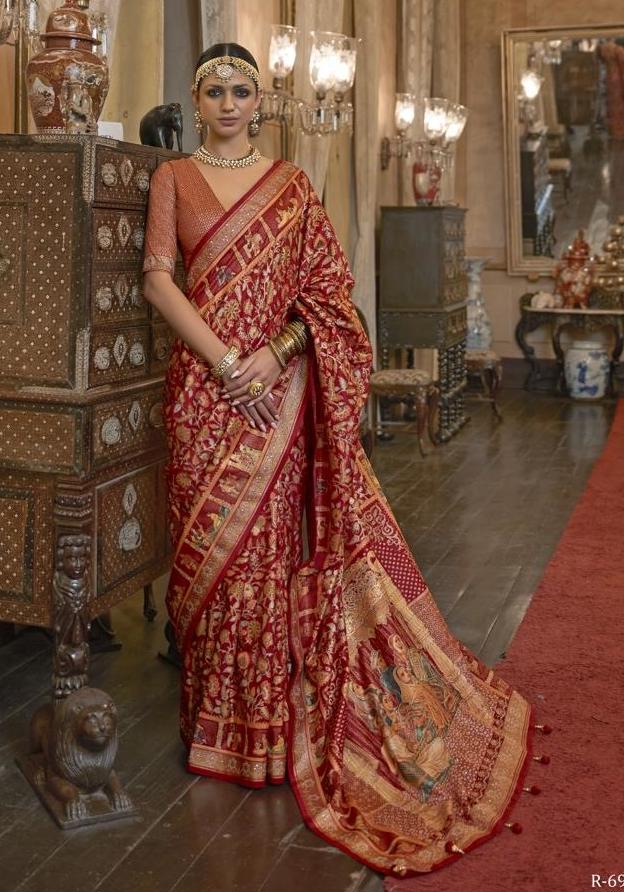
4. Skilled Craftsmanship: Creating Patola sarees requires the expertise of skilled artisans who possess a deep understanding of the weaving technique. The process is time-consuming and requires precision at every step.
5. Traditional and Cultural Significance: Patola sarees hold cultural significance and are often passed down through generations as heirlooms. They are a symbol of the rich heritage and craftsmanship of Gujarat.
6. Expensive and Exclusive: Due to the labor-intensive process and high level of skill involved, Patola sarees are considered luxury items and can be quite expensive. Authentic Patola sarees are limited in number, adding to their exclusivity.
7. Bridal Wear: Patola sarees, with their rich colors and intricate designs, are a popular choice for brides during traditional Gujarati weddings. They add a touch of elegance and cultural authenticity to the wedding attire.
8. Preservation and Care: Given their delicate nature and rich dye colors, Patola sarees require proper care to ensure their longevity. They should be stored away from direct sunlight and exposure to moisture.
9. Contemporary Adaptations: While traditional Patola sarees remain popular, contemporary designers have also incorporated Patola designs into modern silhouettes, giving rise to fusion fashion.
When searching for Patola wedding sarees, ensure that you’re getting an authentic piece from trusted sources or artisans who specialize in this craft. These sarees are not only a stunning addition to a bride’s wardrobe but also a testament to India’s rich textile heritage.
6. Chanderi Silk Wedding Saree
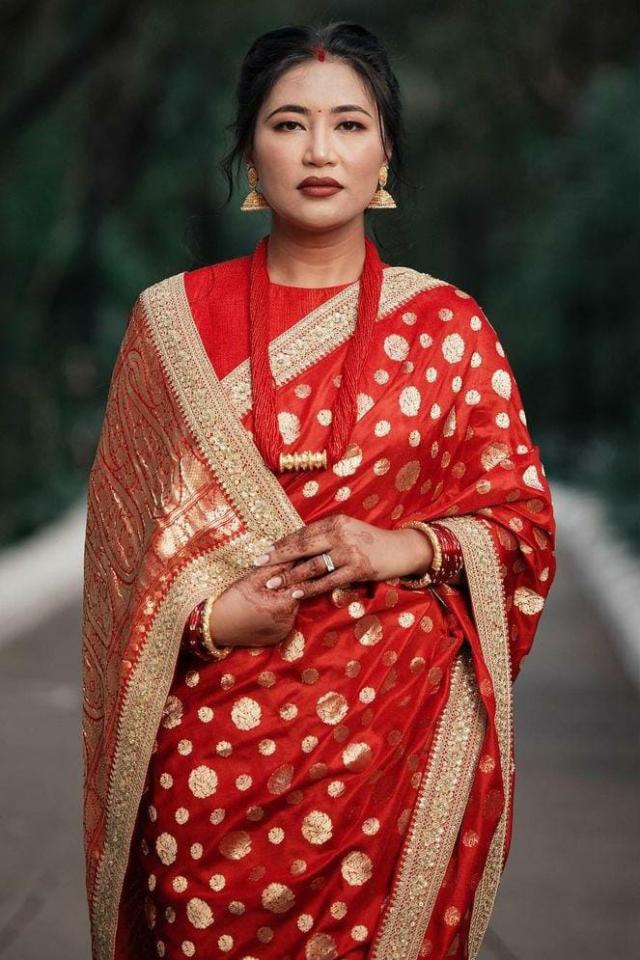
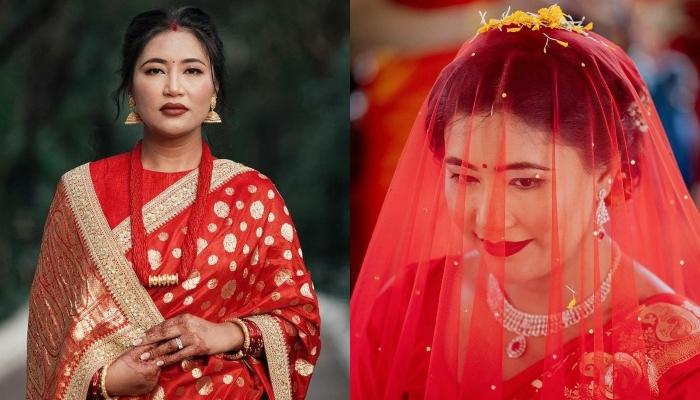
Chanderi silk sarees are renowned for their sheer texture, lightweight feel, and exquisite craftsmanship. They originate from Chanderi, a town in the Ashoknagar district of Madhya Pradesh, India. These sarees have a unique blend of tradition and contemporary design, making them a popular choice for weddings, festive occasions, and special events.
Here are some key details about Chanderi silk wedding sarees:
Fabric: Chanderi sarees are made primarily from three types of fabric – pure silk, Chanderi cotton, and silk cotton. The blend of silk and cotton gives them their characteristic glossy finish and soft texture.
Weaving Technique: Chanderi sarees are woven using a traditional weaving technique that combines silk and cotton threads. The weaving process creates a sheer and lightweight fabric that is comfortable to wear and has a distinctive texture.
Zari Work: Chanderi sarees often feature intricate zari work (metallic thread embroidery), which adds a touch of elegance and glamour to the saree. The zari work can be found on the borders, pallu (end piece of the saree), and body of the saree.
Motifs and Designs: Chanderi sarees are known for their delicate and artistic designs. Common motifs include peacocks, flowers, geometric shapes, and traditional patterns. These motifs are woven into the fabric using different colored threads.
Color Palette: Chanderi silk sarees come in a wide range of colors, from vibrant and bold hues to pastel shades. The choice of colors often depends on the occasion and personal preferences.
Pallu Design: The pallu of a Chanderi silk saree is often a highlight of the design. It may feature intricate zari work, woven patterns, or embellishments that set it apart from the rest of the saree.
Blouse: Chanderi sarees are typically paired with a blouse that complements the saree’s colors and design. Depending on the overall look, blouses can be simple or intricately designed to match the saree’s elegance.
Occasions: Chanderi silk sarees are popular choices for weddings, receptions, festive occasions, and other formal events. They strike a balance between traditional and contemporary styles, making them versatile for various settings.
Maintenance: Due to their delicate nature, Chanderi silk sarees should be handled with care. Dry cleaning is recommended to preserve their quality and intricate work.
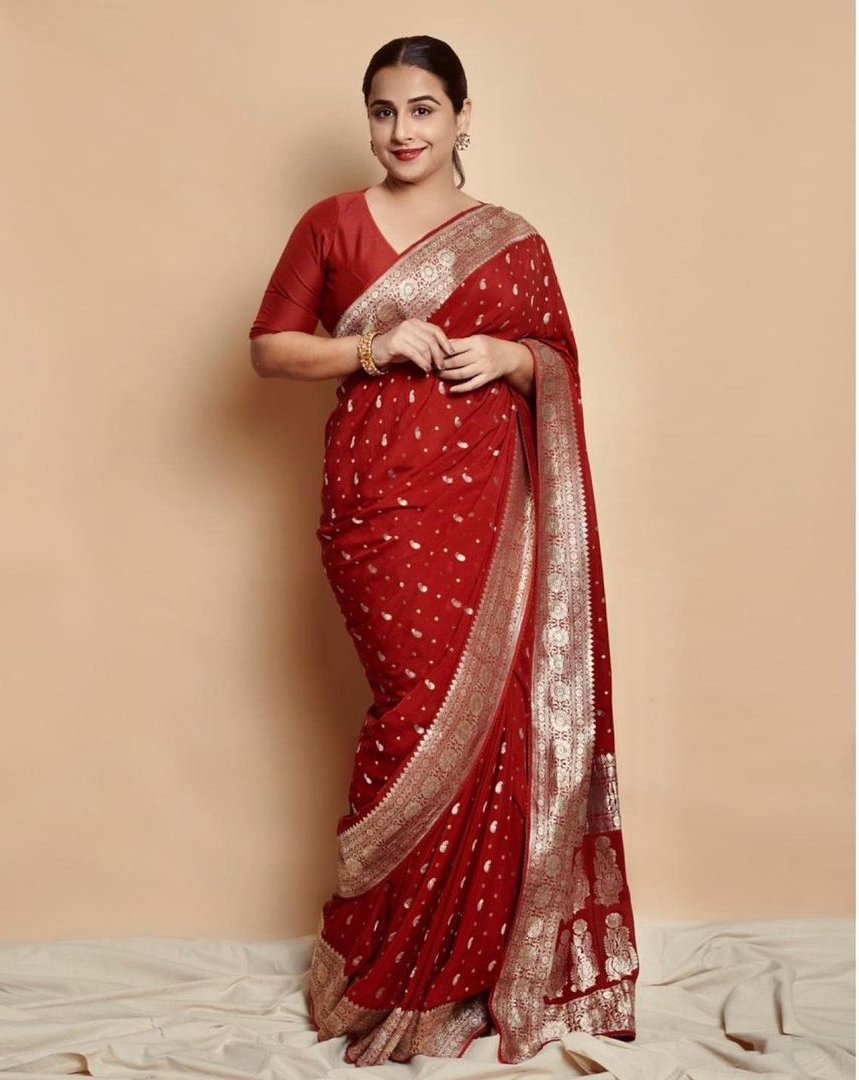
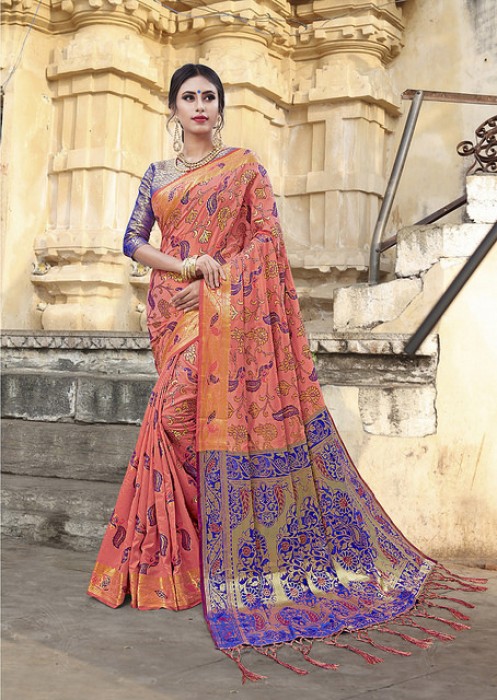
Accessories: To complete the wedding look with a Chanderi silk saree, you can accessorize with traditional jewelry such as jhumkas, bangles, and a statement necklace. A bindi and neatly tied hair can add to the overall elegance.
Chanderi silk wedding sarees are a blend of timeless beauty and modern elegance, making them a favorite choice for brides and women attending weddings. Their sheer texture, intricate zari work, and rich cultural heritage make them a true representation of Indian craftsmanship.
7. Sambalpuri wedding sarees
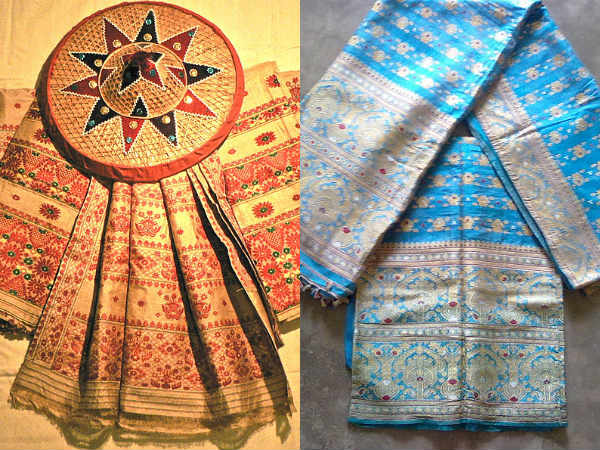
Sambalpuri sarees are a traditional handwoven textile art form from the western Odisha region of India, specifically from the Sambalpur, Bargarh, Sonepur, Balangir, and Nuapada districts. These sarees are renowned for their intricate ikat (tie-dye) designs, vibrant colors, and rich cultural heritage. Sambalpuri sarees are often favored for weddings and other special occasions due to their artistic beauty and traditional significance.
Here are the key details about Sambalpuri sarees, particularly when worn as wedding attire:
Ikat Technique: Sambalpuri sarees are created using the labor-intensive “ikat” technique, where the yarns are resist-dyed before weaving to create intricate patterns. The patterns are carefully planned and tied onto the yarns before dyeing, resulting in a beautiful design that emerges during weaving.
Designs and Motifs: Sambalpuri sarees are known for their rich and varied designs, which often include traditional motifs such as flowers, animals, geometric shapes, and cultural symbols. These motifs hold cultural significance and tell stories of the local heritage.
Color Palette: Sambalpuri sarees come in a wide range of vibrant colors, with each color representing different emotions, occasions, and rituals. Red, maroon, and yellow are commonly used for wedding sarees, symbolizing prosperity and happiness.
Fabrics: Sambalpuri sarees are typically woven from high-quality silk or cotton threads. Both varieties showcase the intricate ikat designs beautifully. The choice of fabric can influence the saree’s texture, drape, and overall look.
Border and Pallu: The saree’s border and pallu (the decorative end piece of the saree) are often designed elaborately with intricate patterns. The pallu is an essential part of the saree and is often the focal point of the design.
Wedding Significance: Sambalpuri sarees are frequently chosen as wedding attire due to their cultural significance and artistic appeal. They are considered a symbol of tradition, heritage, and elegance, making them ideal for special occasions like weddings.
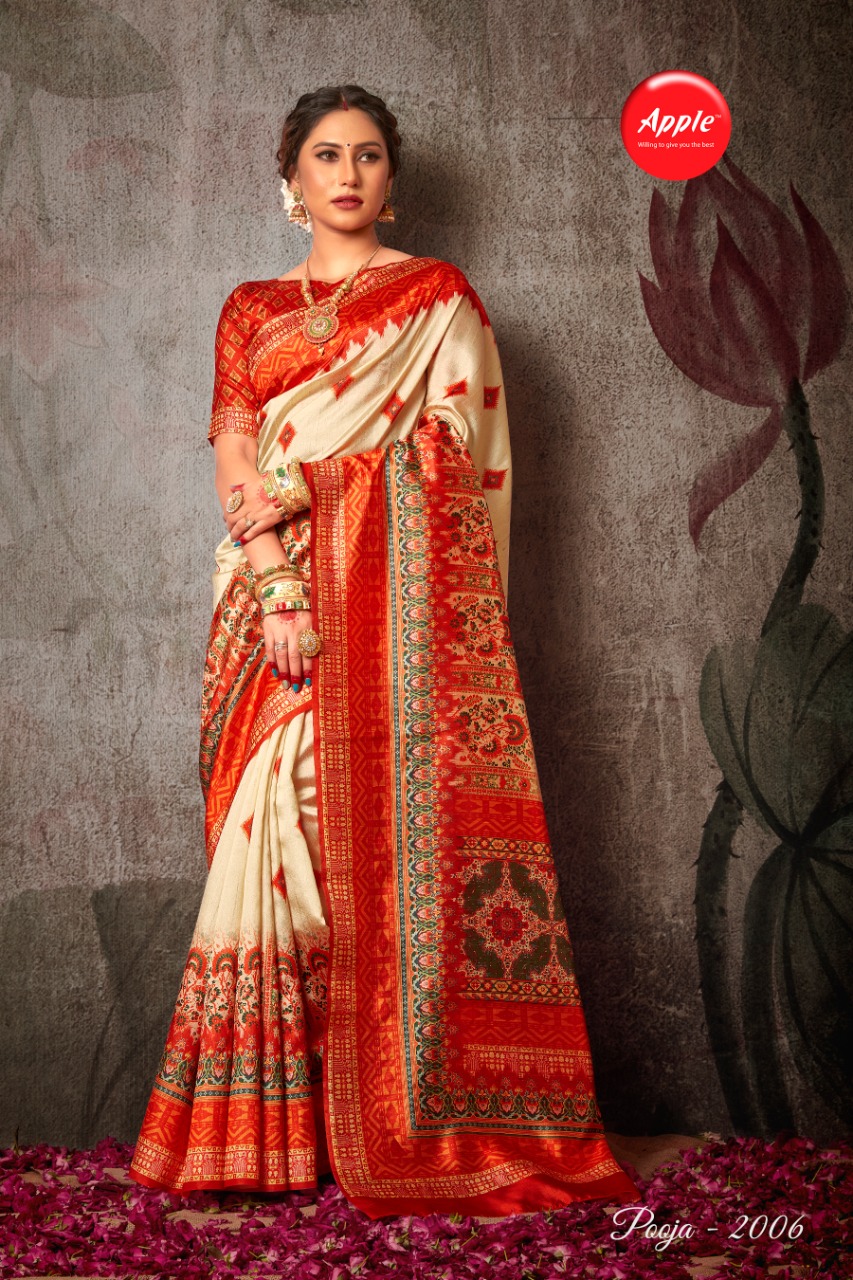
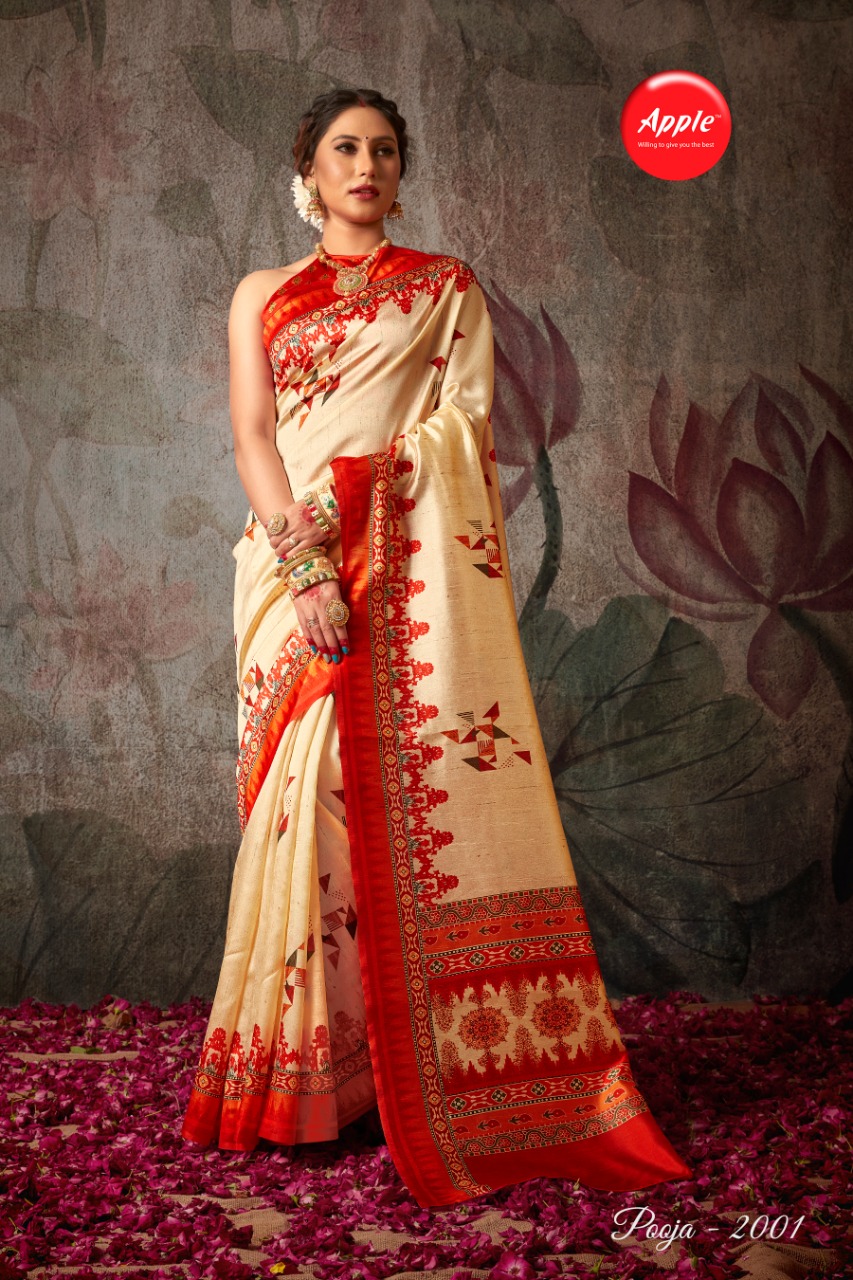
Accessorizing: Sambalpuri sarees can be paired with traditional Odia jewelry, such as filigree work gold jewelry and intricate silver ornaments. The choice of accessories can further enhance the overall bridal look.
Draping Style: The saree is typically draped in the Nivi style, which is a classic and flattering way of draping the six yards of fabric. The pleating, pallu arrangement, and overall drape contribute to the saree’s grace.
Availability: Sambalpuri sarees can be found in various designs, colors, and patterns, catering to different preferences. They are available in both traditional and contemporary styles, making them suitable for diverse tastes.
When choosing a Sambalpuri saree for a wedding, it’s essential to consider your personal style, the color palette that suits you, and the motifs that resonate with your cultural heritage. These sarees not only make a stunning fashion statement but also carry the legacy of Indian textile craftsmanship.
8. Mysore Silk Wedding Saree
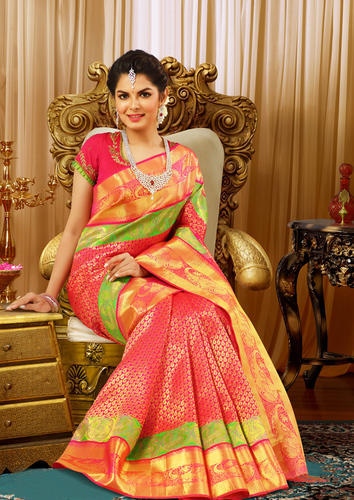
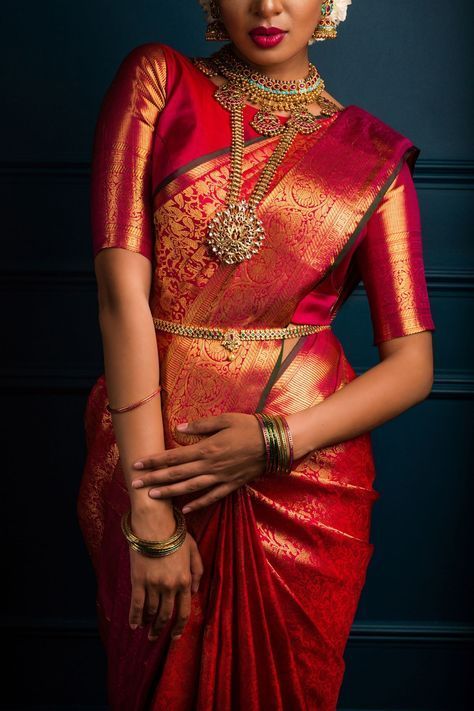
Mysore Silk wedding sarees are renowned for their luxurious quality, intricate designs, and cultural significance. These sarees are made from pure silk and are characterized by their soft texture, vibrant colors, and minimalistic yet elegant designs. They are considered a popular choice for weddings and other special occasions in South India. Here are some key details about Mysore Silk wedding sarees:
Origin: Mysore Silk sarees originate from Mysore, a city in the southern Indian state of Karnataka. The city has a rich history of silk production, and Mysore Silk sarees are a reflection of this tradition.
Fabric: Mysore Silk sarees are made from high-quality silk, which gives them a soft and smooth texture. The silk used in these sarees is known for its durability and luxurious feel.
Designs: Mysore Silk sarees are known for their elegant and sophisticated designs. The sarees often feature intricate borders, pallu (the decorative end of the saree), and body designs. The designs can range from traditional motifs to more contemporary patterns.
Colors: Mysore Silk sarees are available in a wide range of vibrant colors. The color palette includes rich and deep shades that enhance the overall appeal of the saree.
Zari Work: Many Mysore Silk sarees are adorned with zari work, which involves weaving gold or silver threads into the fabric. Zari work adds a touch of opulence and grandeur to the saree.
Pricing: Mysore Silk sarees are considered a luxury product due to the quality of the silk and the craftsmanship involved. As a result, they tend to be on the higher end of the price spectrum.
Occasions: Mysore Silk sarees are commonly worn on special occasions, particularly weddings, festivals, and other traditional celebrations. Their regal appearance makes them a popular choice for brides during their wedding ceremonies.
Maintenance: Due to the delicate nature of silk, Mysore Silk sarees should be handled with care. They should be dry-cleaned or gently hand-washed to maintain their luster and quality.
Varieties: While the traditional Mysore Silk saree is known for its simplicity and elegance, modern variations may incorporate contemporary design elements, such as trendy patterns and unconventional color combinations.
Authenticity: To ensure the authenticity of a Mysore Silk saree, look for the silk mark on the saree, which certifies the quality and genuineness of the silk used.
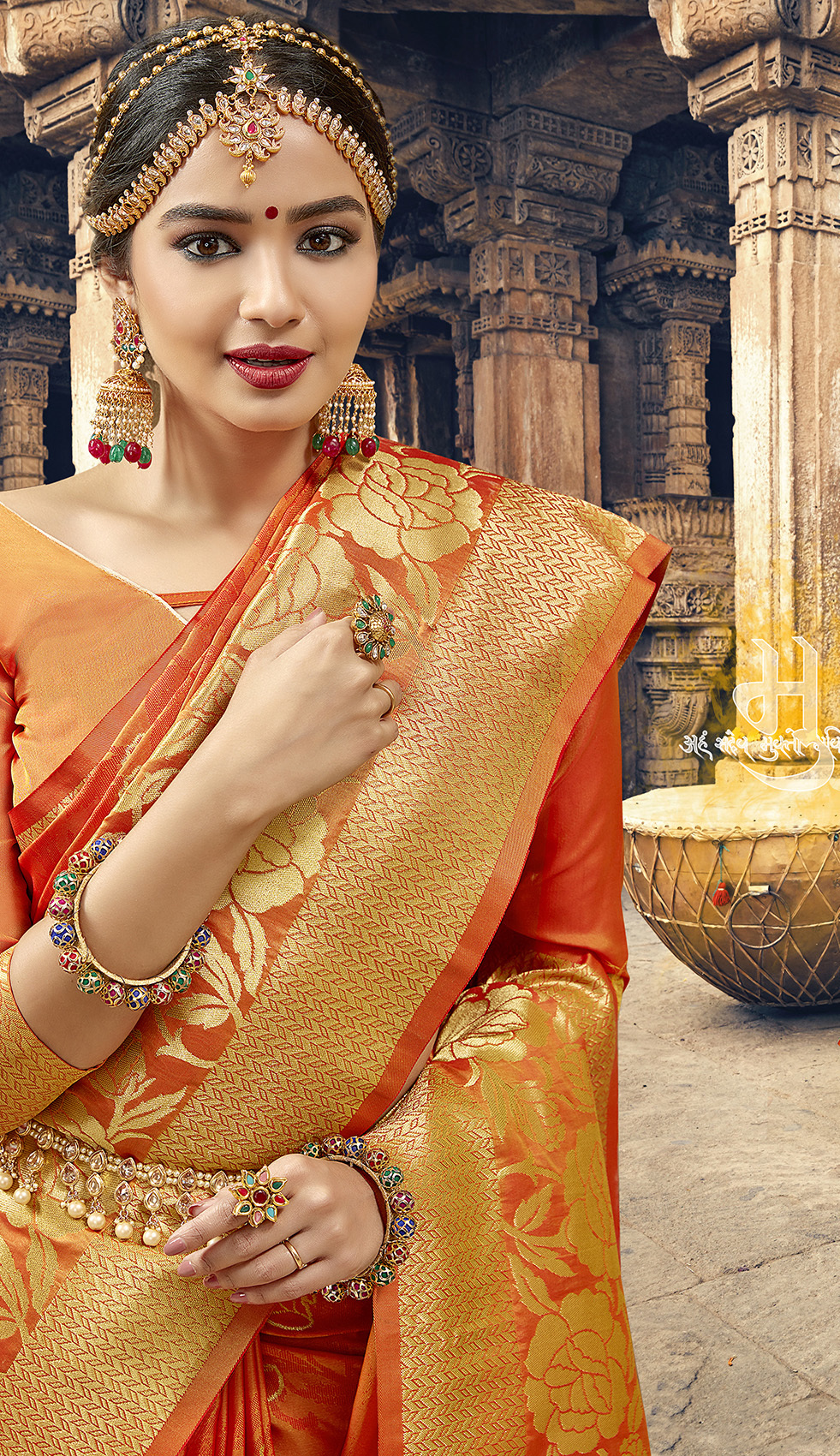
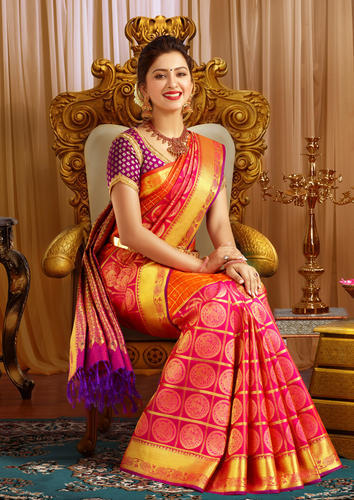
Mysore Silk wedding sarees carry a sense of tradition, culture, and luxury. Their timeless beauty and graceful appeal make them a cherished choice for brides and women who appreciate the artistry and craftsmanship of Indian textiles.
9. Tussar Silk Wedding Saree
Tussar Silk, also known as “Kosa Silk” or “Tasar Silk,” is a type of silk that is produced from the larvae of several species of silk worms found in the wild forests of India. Tussar Silk has a distinct appearance and texture, making it a popular choice for sarees, especially for weddings and special occasions. 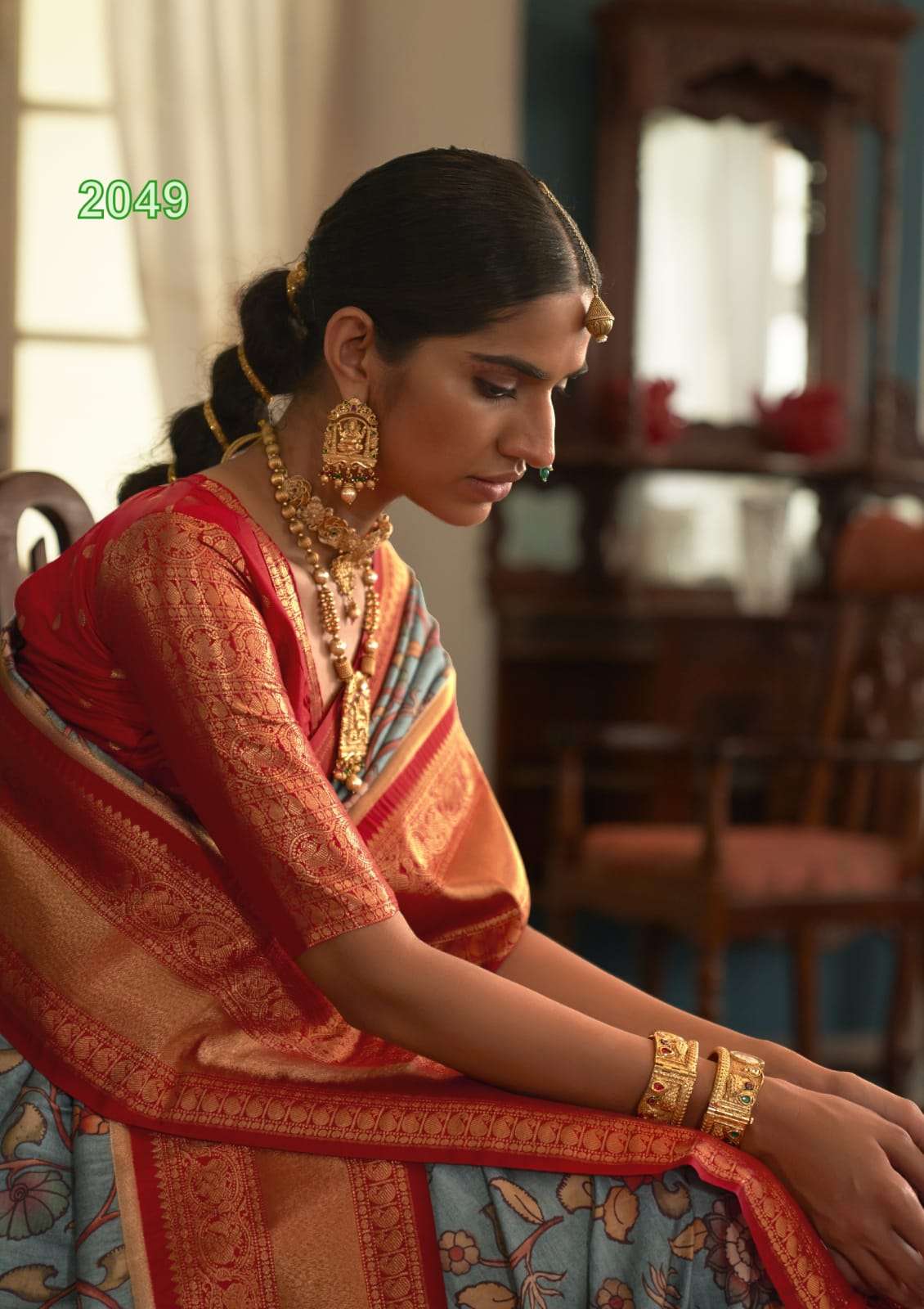
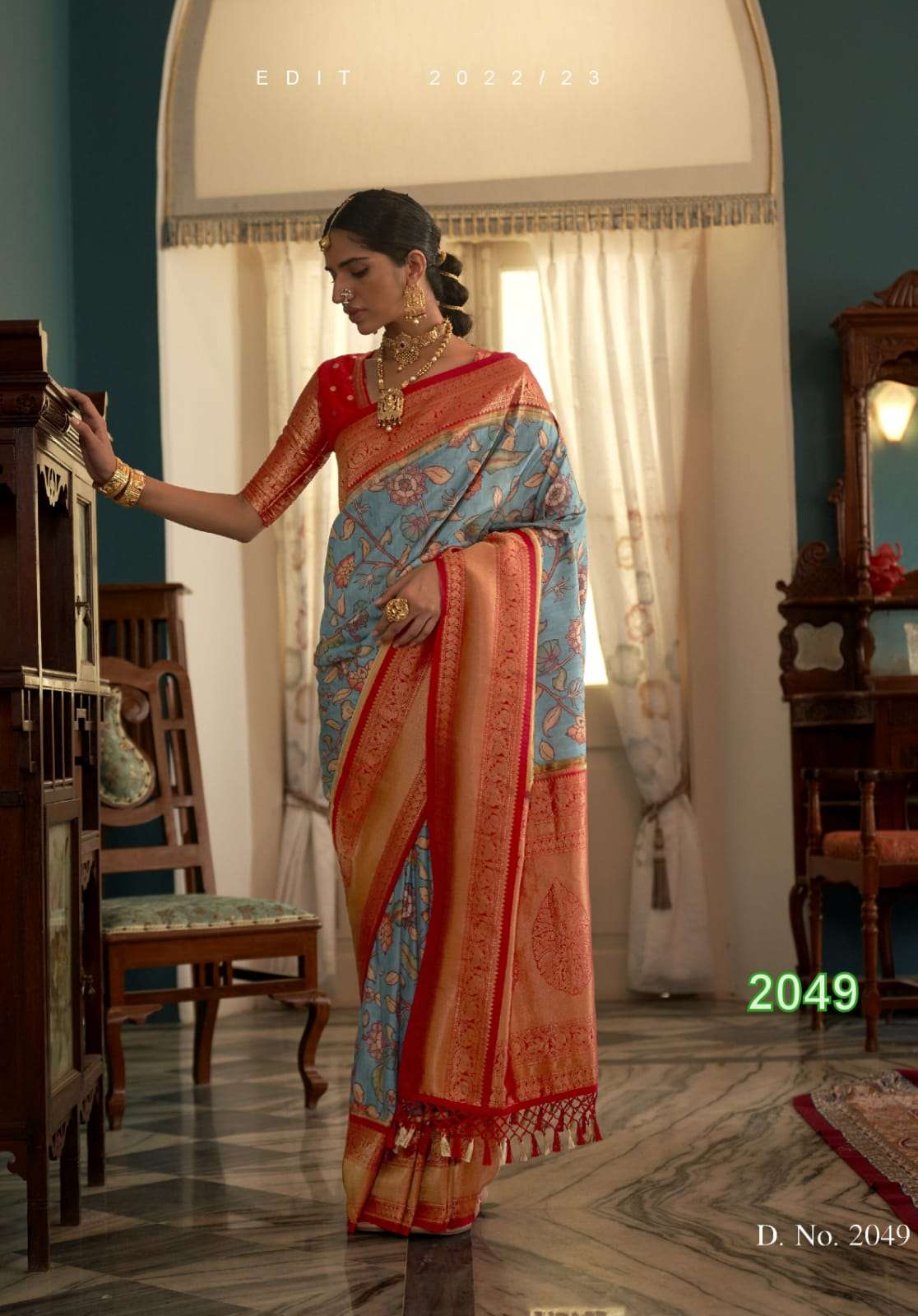
Here are some details about Tussar Silk wedding sarees:
Origin and Availability: Tussar Silk is primarily produced in states like West Bengal, Bihar, Jharkhand, and Odisha in India. The silk is obtained from the Antheraea moth, which spins its cocoon on trees in the forest. Due to its natural and wild production process, Tussar Silk has a unique appeal.
Texture and Feel: Tussar Silk has a slightly coarse texture compared to other types of silk. This texture gives it a rustic and earthy charm. The fabric is breathable and comfortable to wear, making it suitable for both warm and cool weather.
Colors and Designs: Tussar Silk wedding sarees come in a wide range of colors, from subtle pastels to vibrant shades. They often feature intricate handwoven designs, including traditional motifs, floral patterns, and geometric shapes. The natural sheen of Tussar Silk enhances the visual appeal of these sarees.
Embroidery and Embellishments: Tussar Silk sarees are often adorned with various types of embroidery, such as Zari work, Resham (silk) embroidery, and mirror work. These embellishments add a touch of glamour and elegance to the saree.
Blouse and Styling: Tussar Silk wedding sarees are usually paired with matching or contrasting blouses. Depending on the design and embellishments of the saree, the blouse can be kept simple or made more elaborate. Tussar Silk sarees can be draped in various traditional styles, and their rich texture adds depth to the overall look.
Occasions: Tussar Silk wedding sarees are a popular choice for brides and attendees at traditional Indian weddings. They are also suitable for other festive occasions and celebrations. The uniqueness of Tussar Silk sets it apart and adds a distinct charm to the wedding ensemble.
Maintenance: Tussar Silk sarees should be handled with care to ensure their longevity. They are often dry-cleaned to maintain their texture and colors. Avoid exposing the saree to direct sunlight for prolonged periods to prevent color fading.
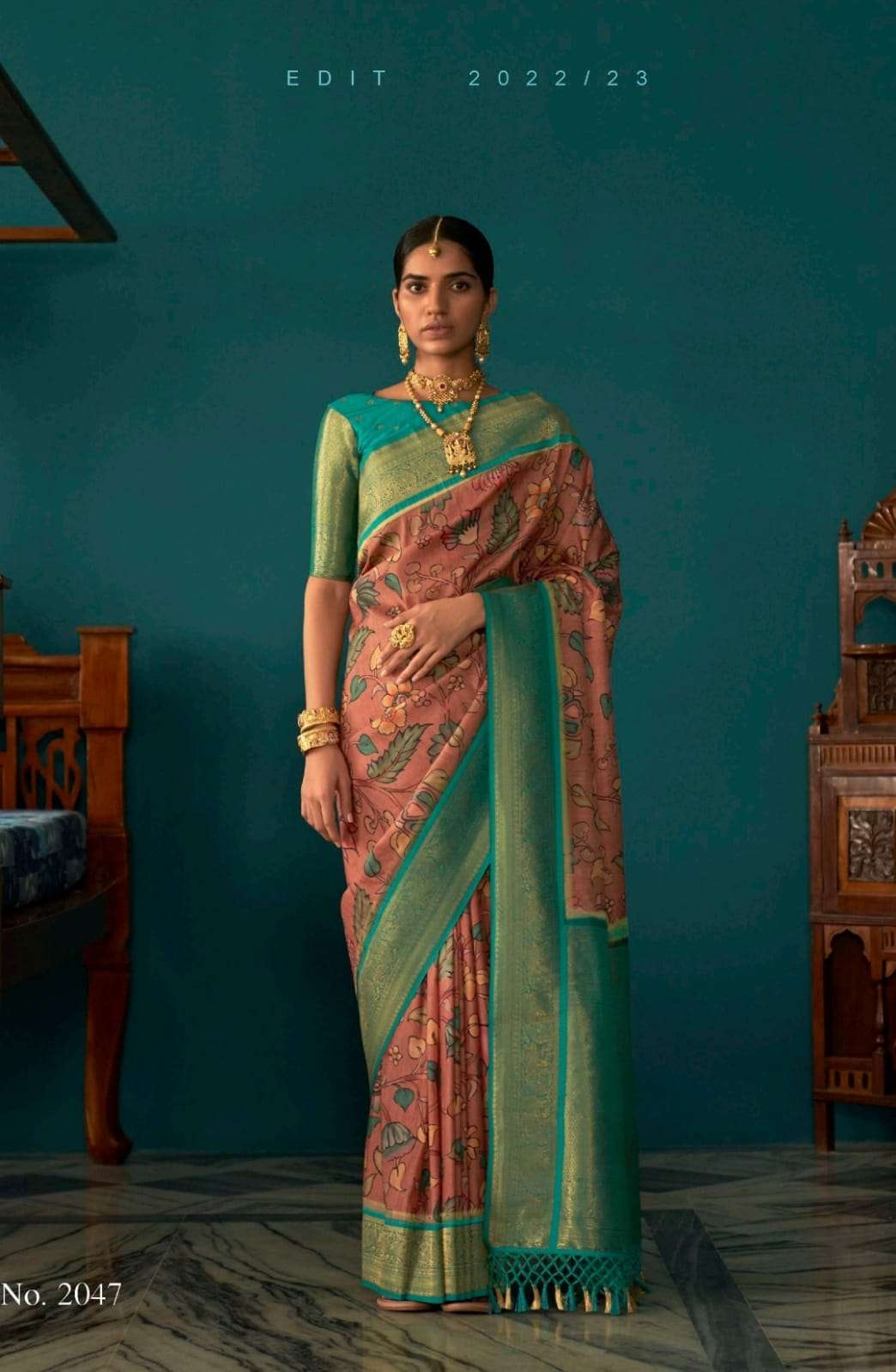
Price Range: The price of Tussar Silk wedding sarees varies depending on factors such as the quality of the silk, the intricacy of the design, and the presence of embellishments. Handwoven and intricately designed sarees are likely to be more expensive.
Tussar Silk wedding sarees are a wonderful choice for those who appreciate the natural beauty of silk with a touch of traditional elegance. Their distinct texture and charm make them stand out in the realm of wedding attire.
10 Baluchari Wedding Saree

Baluchari sarees are a type of traditional silk saree that originated in the town of Baluchar in West Bengal, India. These sarees are known for their intricate woven designs and vibrant colors, making them popular choices for weddings and other special occasions.


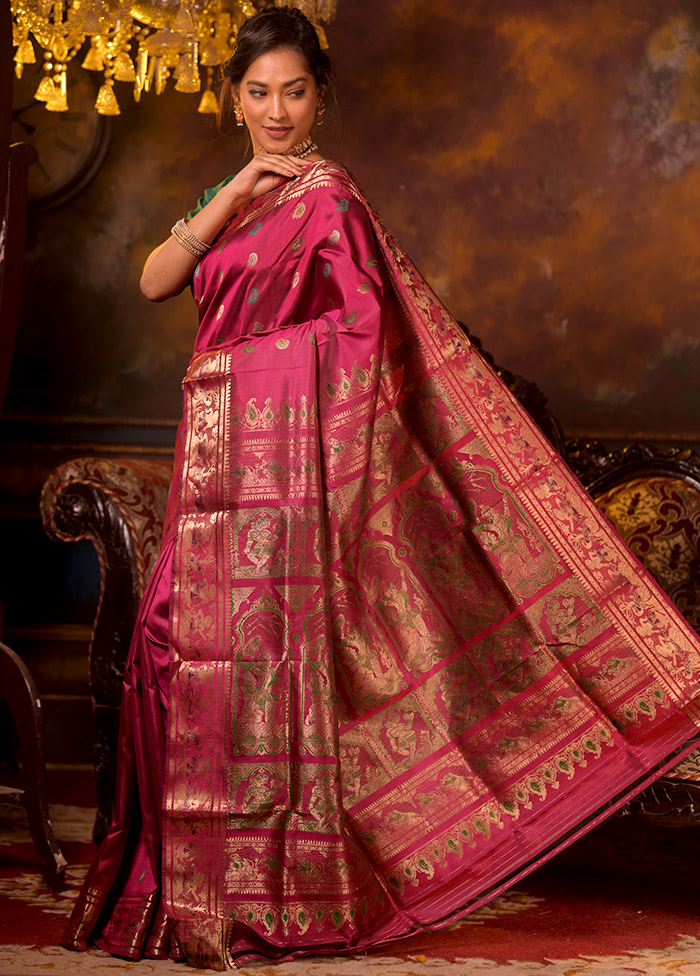
Here are some key details about Baluchari wedding sarees:
Origin and History: Baluchari sarees have a rich history dating back to the 18th century during the reign of the Nawabs of Bengal. Originally, these sarees were woven with intricate motifs and scenes from Indian mythology, particularly from the epics like the Ramayana and Mahabharata. The weaving technique and design concepts have been passed down through generations.
Weaving Technique: Baluchari sarees are traditionally woven using the jacquard weaving technique. This technique allows for the creation of intricate and detailed patterns on the saree’s fabric. The weaving process involves using different colored threads to create the desired motifs.
Design and Motifs: One of the distinguishing features of Baluchari sarees is their elaborate woven designs. The sarees often feature scenes from Indian mythology, royal courts, wildlife, and intricate floral patterns. The designs are woven into the fabric, creating a seamless and beautiful look.
Material: Baluchari sarees are typically made from silk, which adds to their elegance and richness. The silk used in these sarees is of high quality, and the fine texture of the silk allows for intricate weaving.
Color Palette: Baluchari sarees are known for their vibrant and bold color choices. The colors used in these sarees often complement the richness of the silk and enhance the overall look of the design.
Occasions: Baluchari sarees are highly coveted for weddings, festive occasions, and special events. The intricate designs and luxurious silk make them a perfect choice for brides who want to showcase traditional craftsmanship and elegance on their wedding day.
Blouse and Accessories: Baluchari sarees are usually paired with contrast blouses that complement the colors of the saree’s design. Heavy traditional jewelry, such as gold necklaces, earrings, and bangles, are often worn to complete the bridal look.
Availability: Baluchari sarees are available in various designs and color combinations. While traditional designs are still popular, contemporary variations with modern motifs and colors are also crafted to cater to changing tastes.
Cultural Significance: Baluchari sarees hold cultural significance in West Bengal and are often considered a symbol of tradition, artistry, and heritage. They are worn with pride during festivals, weddings, and other important cultural events.
Care: Due to the delicate nature of the silk and intricate weaving, Baluchari sarees require proper care. They should be stored in a cool and dry place, away from direct sunlight. Dry cleaning is recommended for cleaning these sarees.
Baluchari sarees are not just garments; they are pieces of art that carry the legacy of traditional weaving techniques and stories from Indian mythology. Their elegance, intricate designs, and cultural significance make them a popular choice for brides and women looking for a truly special and unique saree for their wedding day.
11. Lehenga Wedding Saree
A Lehenga Saree is a beautiful and versatile garment that combines the elegance of a saree with the convenience of a lehenga. It’s a popular choice for weddings and other special occasions, offering a stunning and contemporary look while being easier to wear than a traditional saree.
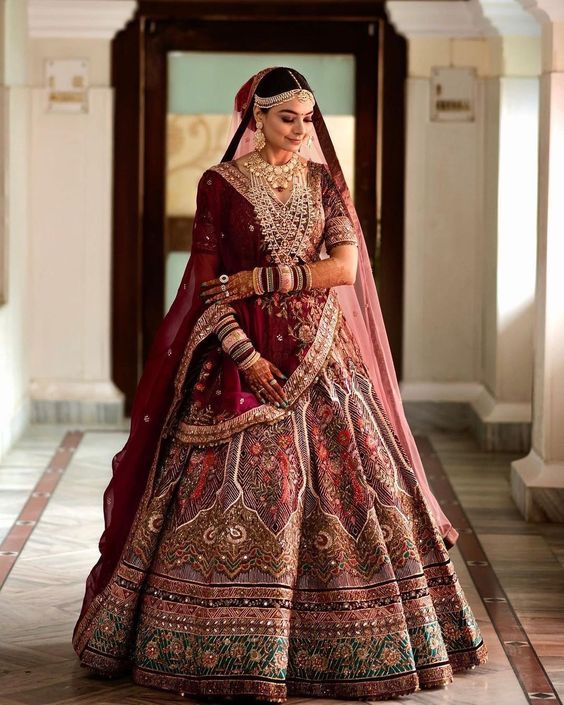
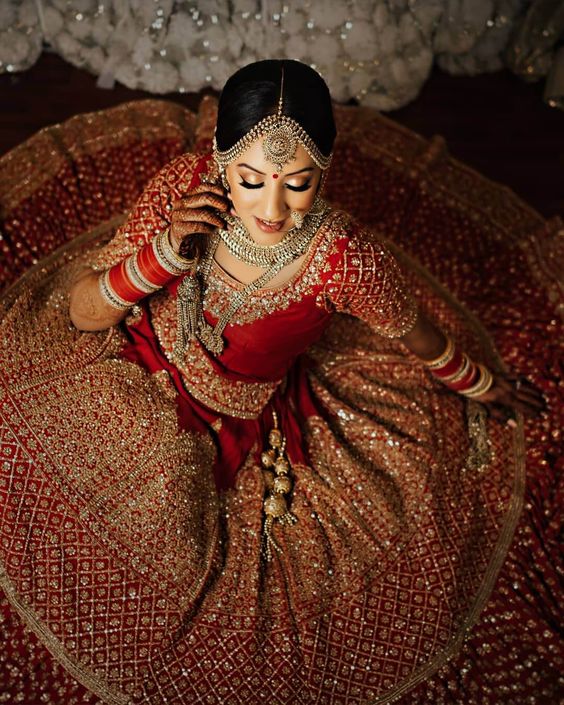
Here are the key details about Lehenga Wedding Sarees:
1. Design: A Lehenga Saree features a combination of a lehenga (a flared skirt) and a saree drape. The lehenga is typically pre-stitched and has a waistband, giving it a skirt-like appearance. The saree drape is attached to the lehenga and is often draped over one shoulder.
2. Draping: Unlike a traditional saree, which requires intricate draping skills, the Lehenga Saree is relatively easy to wear. It eliminates the need for pleating and tucking, making it a popular choice among women who are not comfortable with traditional saree draping.
3. Blouse: Lehenga Sarees are usually paired with designer blouses that complement the overall look. These blouses can feature various necklines, sleeve lengths, and embellishments, adding to the modern appeal of the outfit.
4. Embellishments: Lehenga Sarees often come adorned with exquisite embellishments, such as intricate embroidery, sequins, beads, stones, and zari work. These embellishments enhance the beauty of the outfit and make it perfect for weddings and festive occasions.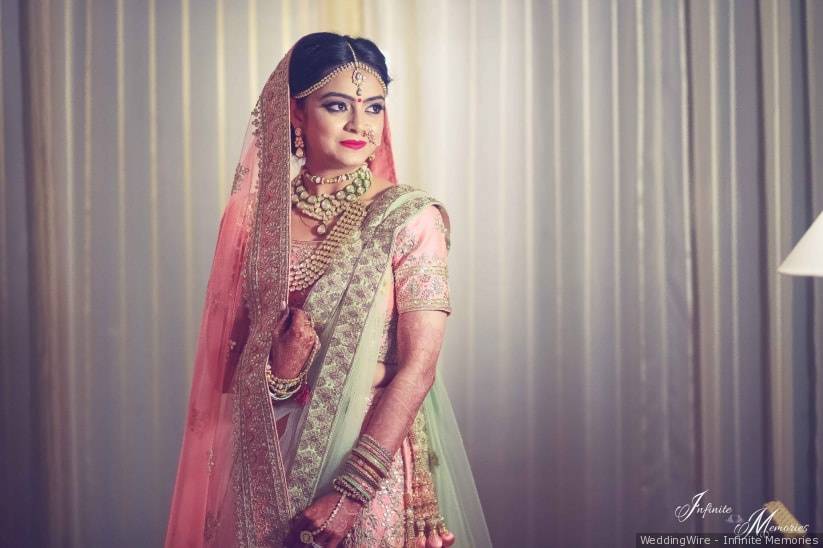
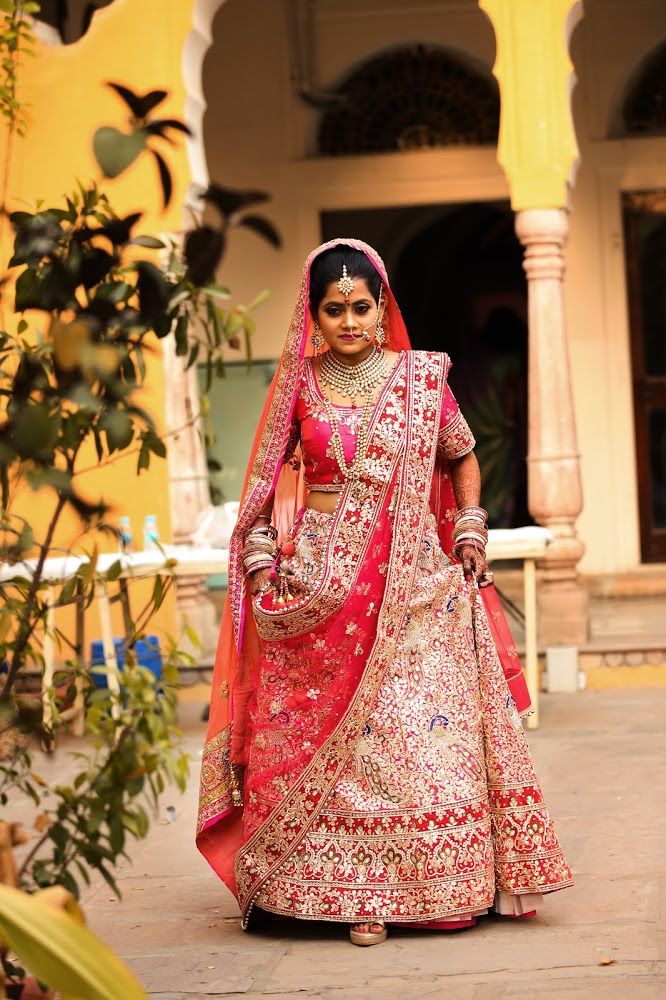
5. Fabrics: Lehenga Sarees are available in a wide range of fabrics, including silk, georgette, chiffon, crepe, net, and more. The choice of fabric can significantly influence the drape, look, and comfort of the outfit.
6. Styles: There are various styles of Lehenga Sarees to choose from, including:
- A-line Lehenga Saree: The lehenga skirt forms an A-shape silhouette, which is universally flattering.
- Mermaid Lehenga Saree: The lehenga flares out dramatically towards the bottom, resembling a mermaid’s tail.
- Straight-cut Lehenga Saree: The lehenga skirt has a straight, column-like shape, offering a contemporary and elegant look.

7. Accessories: When wearing a Lehenga Saree, you can accessorize it with statement jewelry, such as chandelier earrings, a statement necklace, and bangles. Traditional footwear like heels or embroidered flats complete the ensemble.
8. Occasions: Lehenga Sarees are a popular choice for various occasions, including weddings, receptions, sangeet ceremonies, and festive parties. They offer a modern twist to traditional Indian attire.
9. Colors and Trends: The color palette for Lehenga Sarees can range from traditional reds and golds to contemporary pastels and metallic shades. Trends in Lehenga Saree designs can vary from season to season, influenced by fashion trends and the preferences of brides and fashion enthusiasts.
Lehenga Sarees are a perfect blend of tradition and contemporary fashion, making them a sought-after choice for brides and anyone attending special events. They offer the grace of a saree with the comfort of a lehenga, creating a stunning and hassle-free ensemble for any celebration.
12. Gota Patti Wedding Saree:
Gota Patti, also known as Gota work or Gota embroidery, is a traditional form of embellishment that involves the use of small pieces of ribbon, lace, or fabric, often made of gold or silver, to create intricate designs on fabric. This form of decoration is commonly used in Indian wedding attire, particularly in Rajasthan and Gujarat. Gota Patti work adds a touch of opulence and elegance to bridal and festive wear, including sarees.
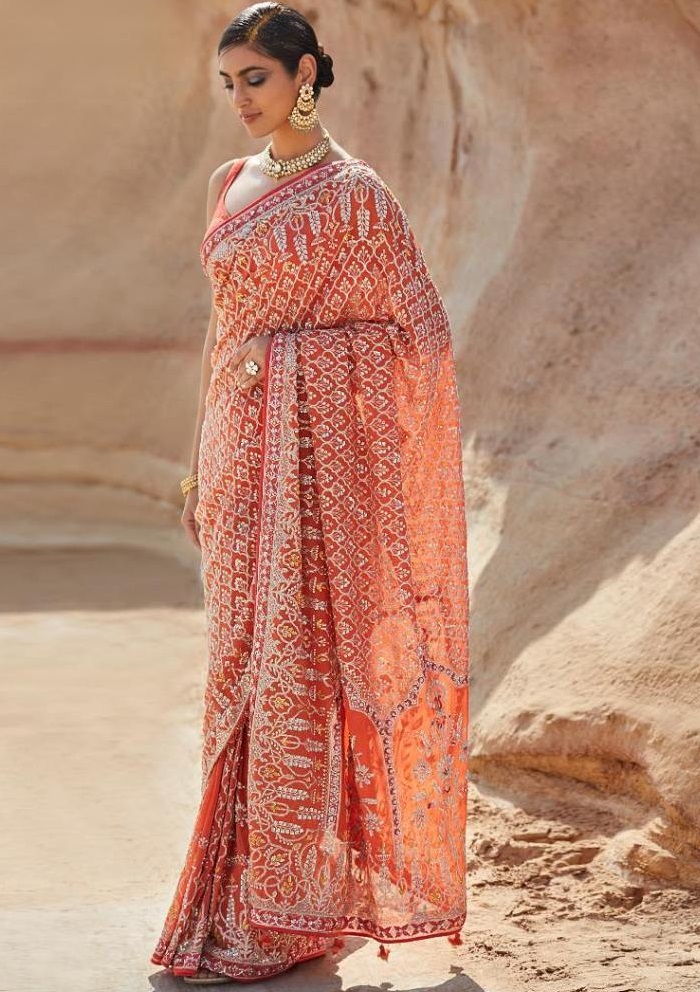
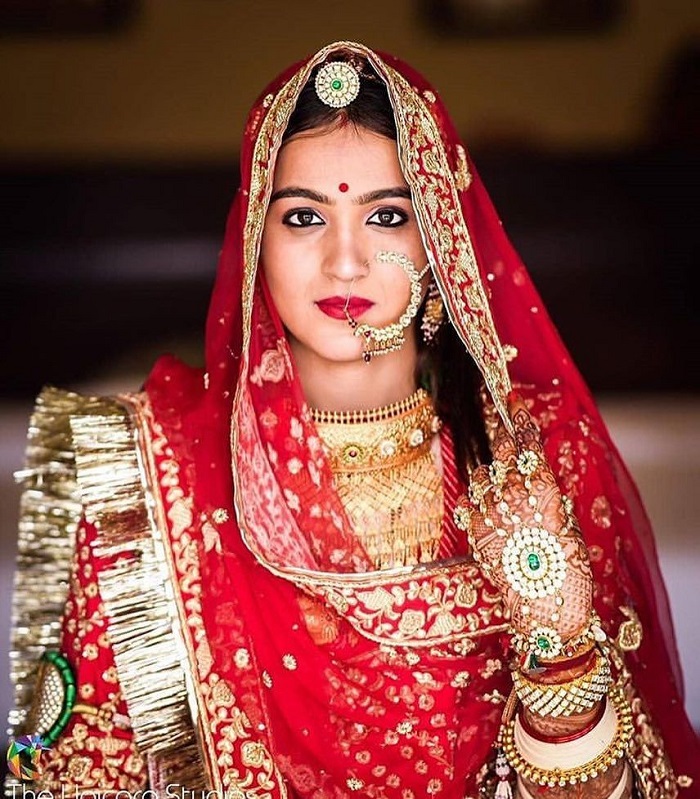
Here are the key details about Gota Patti wedding sarees:
Origin and History: Gota Patti work has its roots in Rajasthan and is deeply embedded in the cultural heritage of the region. It has been traditionally used to adorn wedding attire and festive garments.
Materials Used: Gota Patti work is typically created using narrow strips of gold or silver zari ribbon, silk fabric, or metallic lace. These strips are cut into various shapes and sizes, then meticulously hand-sewn onto the fabric to form intricate patterns.
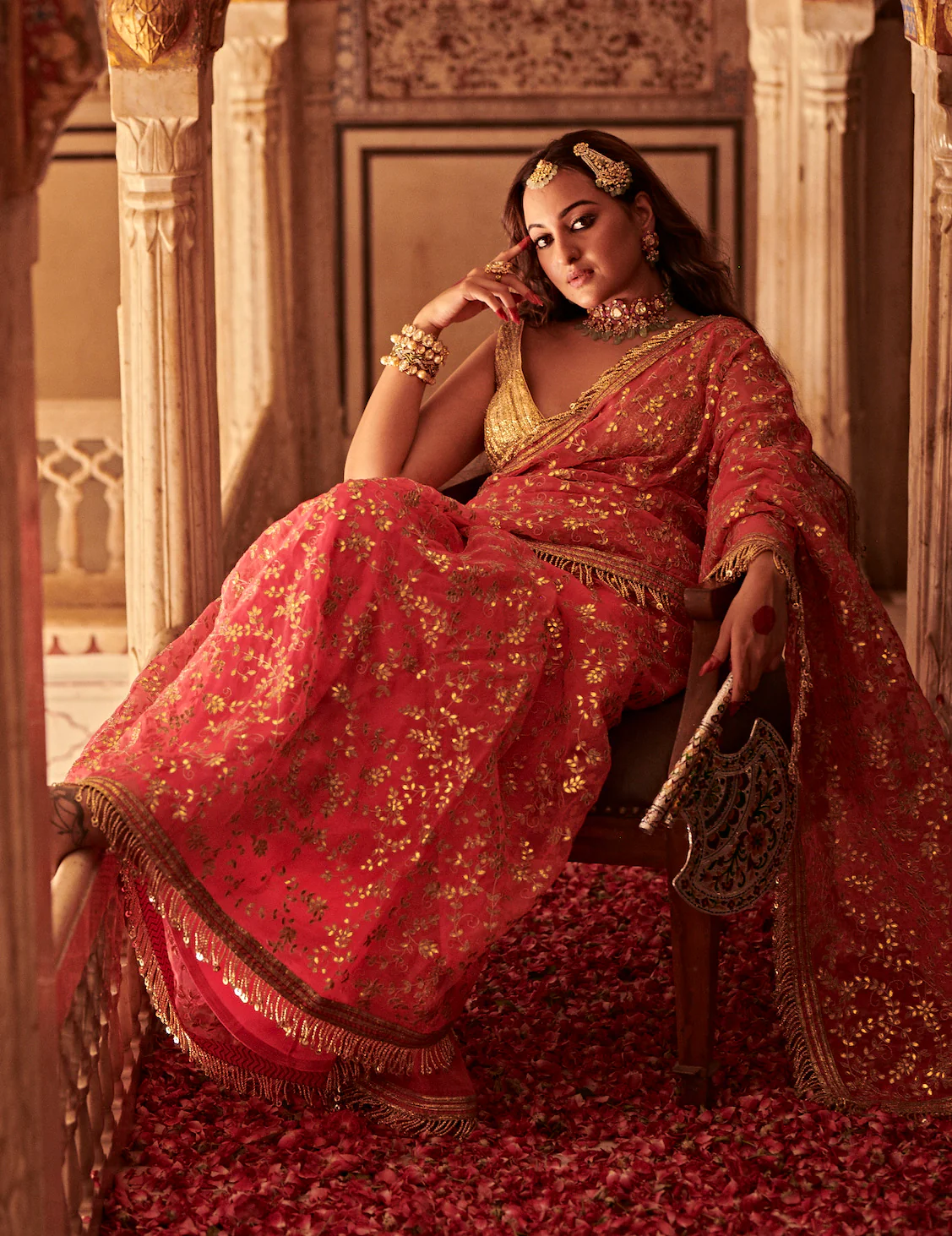
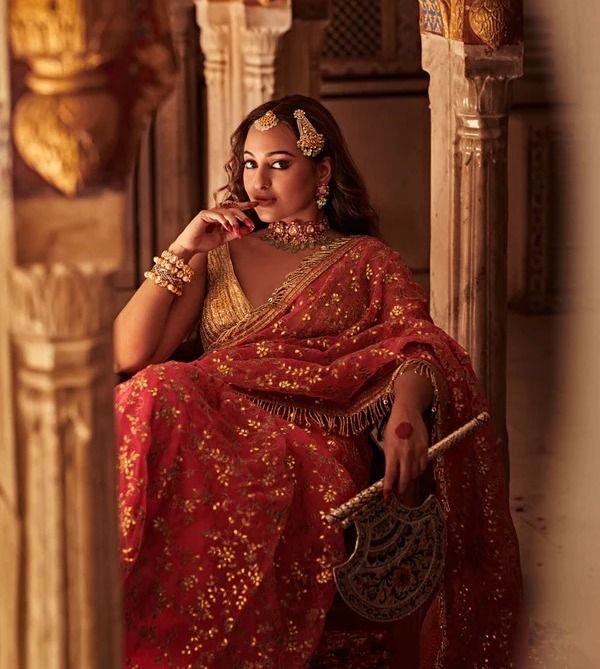
Designs and Patterns: Gota Patti work often features elaborate floral and paisley motifs, along with geometric shapes and intricate borders. The designs are created by layering and stitching the pieces onto the fabric, resulting in a three-dimensional effect.
Color Palette: Gota Patti work is commonly found in vibrant colors, reflecting the festive and celebratory nature of Indian weddings. Bright colors like red, pink, green, and gold are frequently used.
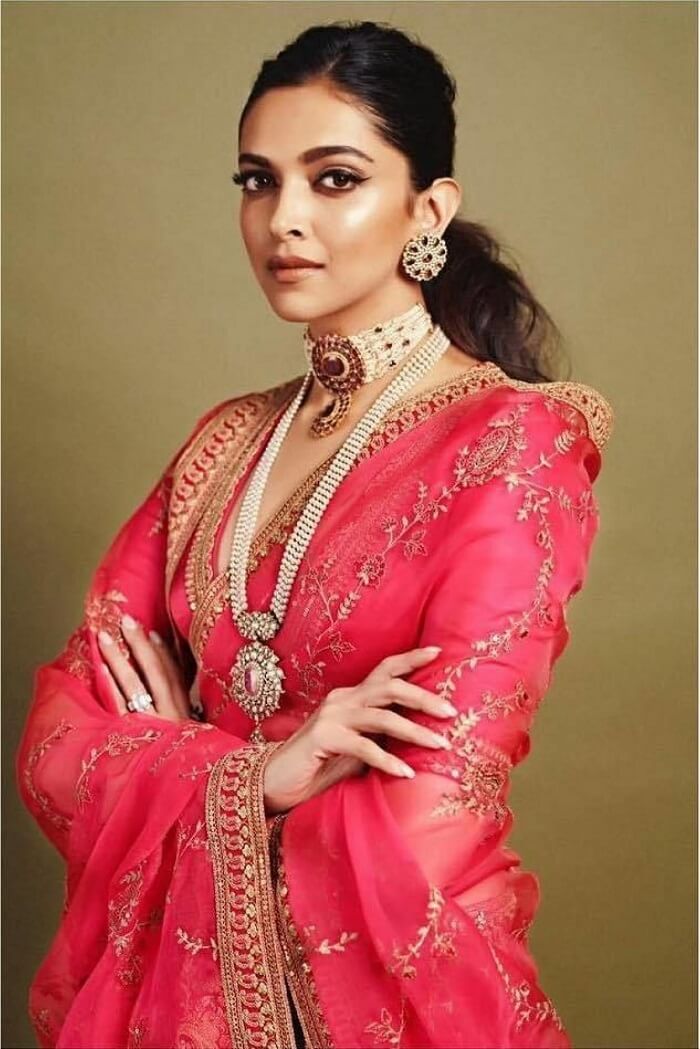
Application on Sarees: Gota Patti work is used to embellish various parts of a saree, including the border, pallu (the decorative end of the saree), and even the body of the saree. The designs can be both traditional and contemporary, catering to a wide range of tastes.
Occasions: Gota Patti wedding sarees are often chosen for bridal wear, as they exude grandeur and richness. They are commonly worn during pre-wedding functions, wedding ceremonies, and other festive occasions.
Variations: There are different styles and techniques of Gota Patti work, and the level of intricacy can vary. Some sarees feature heavy Gota Patti work covering a significant portion of the fabric, while others may have more delicate and scattered embellishments.
Pairing and Styling: Gota Patti wedding sarees are often paired with traditional jewelry, such as Kundan, Polki, or Meenakari sets. The choice of accessories can enhance the overall look and complement the intricacies of the saree.
Contemporary Twist: While Gota Patti work has a traditional origin, contemporary designers often incorporate modern elements to create fusion looks that blend traditional elegance with modern aesthetics.
Availability: Gota Patti wedding sarees can be found in various boutiques, designer stores, and online marketplaces specializing in ethnic wear. They can be custom-made to suit individual preferences.
Gota Patti wedding sarees are a popular choice among brides and those attending weddings due to their intricate craftsmanship and stunning visual appeal. They capture the essence of Indian culture and tradition while embracing creativity and innovation.
13. Chikankari Wedding Saree
Chikankari is a traditional form of hand-embroidery that originates from Lucknow, India. It is renowned for its intricate and delicate floral embroidery, typically done on fine muslin or cotton fabric. Chikankari sarees are a popular choice for weddings and special occasions due to their timeless elegance and craftsmanship.
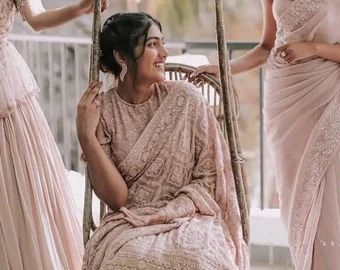
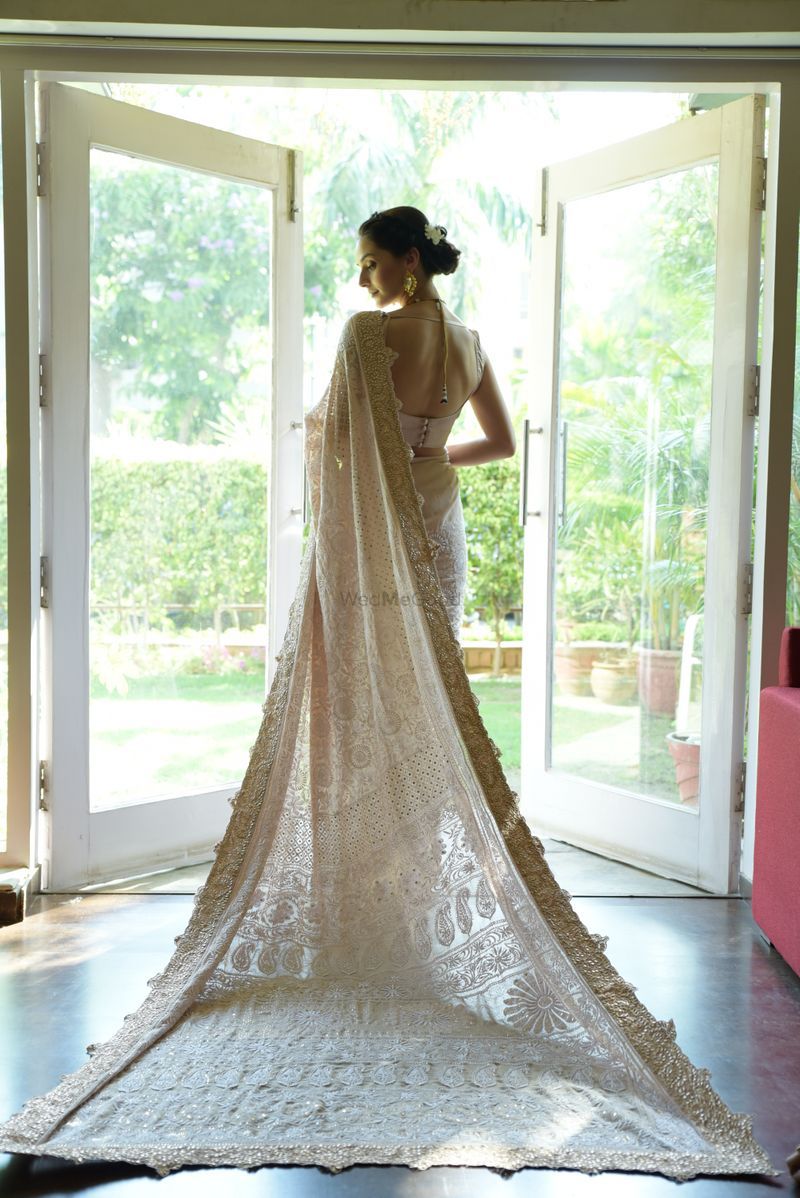
Here are some details about Chikankari wedding sarees:
Embroidery Technique: Chikankari involves intricate white thread embroidery, usually done in shadow work, which creates a subtle play of light and shadow on the fabric. The embroidery often features motifs like flowers, paisleys, vines, and birds.
Fabric: Chikankari work is primarily done on lightweight fabrics like muslin, cotton, georgette, chiffon, and silk. Muslin and cotton are particularly favored for their comfort and breathability, making them suitable for various weather conditions.


Colors: Traditional Chikankari is done using white thread on a white or pastel-colored base fabric. However, modern variations often incorporate colored threads to create a wider range of options for different occasions.
Motifs and Patterns: Chikankari embroidery is known for its intricate patterns and motifs. Some common motifs include “phool” (flowers), “jaal” (net-like patterns), “paisley” (mango-shaped motif), “bakhiya” (shadow work), and “murri” (small dot-like motifs).
Variations: Chikankari sarees come in various styles and variations. Some sarees have all-over embroidery, while others have border and pallu work. There are also Chikankari sarees with contrasting thread colors and embellishments like sequins and beads.
Occasions: Chikankari wedding sarees are a popular choice for brides, bridesmaids, and wedding guests. The elegance and subtlety of Chikankari make it suitable for both daytime and evening wedding events.
Accessories: Chikankari sarees can be paired with traditional jewelry such as jhumkas, bangles, and statement necklaces. The choice of accessories can be adapted based on the color and style of the saree.
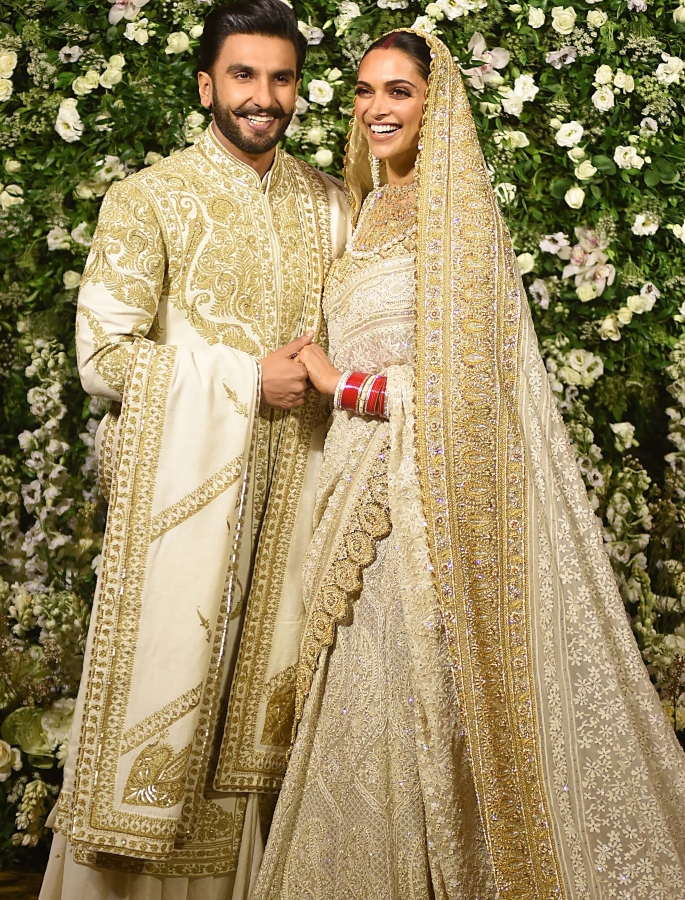
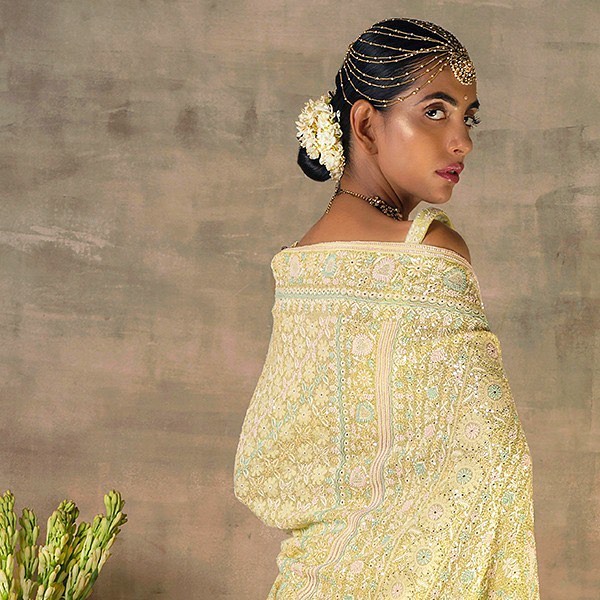
Styling: Chikankari sarees exude an understated charm, so makeup and hairstyle choices should complement the grace of the outfit. Soft curls, elegant updos, and minimalistic makeup often work well.
Maintenance: Chikankari sarees require gentle care due to their delicate embroidery. They should be dry-cleaned to ensure the embroidery remains intact. When storing, it’s best to wrap them in muslin or cotton cloth to prevent any damage.
Availability: Chikankari sarees can be found in various boutiques, online stores, and traditional markets. Lucknow is a prime location to explore and purchase authentic Chikankari sarees.
Chikankari wedding sarees symbolize timeless elegance and celebrate the rich cultural heritage of Lucknow. They beautifully blend tradition with contemporary style, making them a cherished choice for brides and those attending weddings.
14. Kota Doria Wedding Saree
Certainly! Konrad saree, also known as Temple saree, is a traditional South Indian silk saree that hails from the state of Tamil Nadu. It is known for its unique and distinctive designs, often featuring temple-inspired motifs.
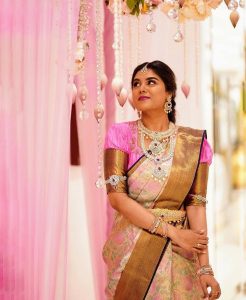
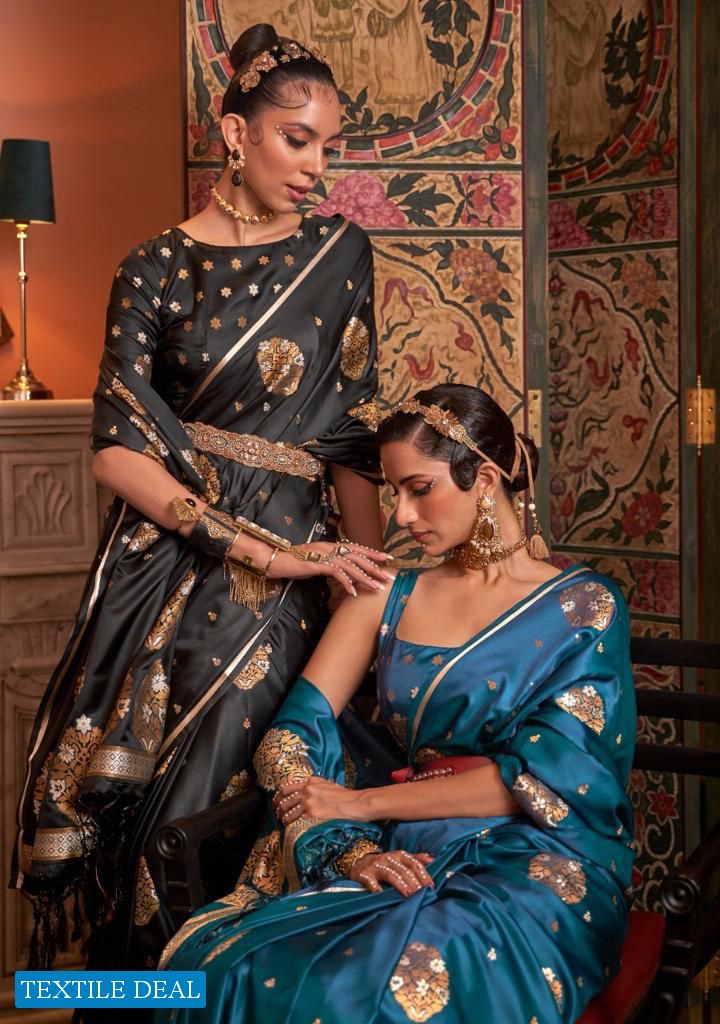
Here are the key details about Konrad wedding sarees:
Origin and Significance: Konrad sarees have a rich cultural heritage and are closely associated with South Indian temples and religious ceremonies. The saree’s designs are often inspired by the intricate carvings and sculptures found in ancient temples, making them a symbol of traditional craftsmanship and devotion.
Material: Konrad sarees are typically woven using pure silk threads. The silk used is of high quality and lends the saree its luxurious feel and rich texture.
Designs and Motifs: The defining feature of a Konrad saree is its intricate motifs, which often include depictions of temple architecture, idols, flowers, peacocks, and other traditional patterns. These motifs are meticulously woven into the saree’s body and borders.
Color Palette: Konrad sarees are available in a wide range of colors, both vibrant and subtle. The color choices often complement the temple-inspired motifs, creating a harmonious and elegant look.
Border and Pallu: The border of a Konrad saree is usually broad and heavily adorned with intricate designs. The pallu (the loose end of the saree that drapes over the shoulder) also carries elaborate motifs, contributing to the overall grandeur of the saree.
Occasions: Konrad sarees are most commonly worn on special occasions, particularly weddings and religious ceremonies. They are favored by brides for their traditional charm and opulent appeal.
Blouse: The blouse paired with a Konrad saree is often chosen to complement the saree’s color and design. The blouse may feature matching or contrasting embroidery to enhance the overall look.
Accessorizing: When wearing a Konrad saree, traditional gold jewelry is often chosen to complement its richness. This includes necklaces, earrings, bangles, and hair ornaments that enhance the overall bridal look.
Maintenance: As with all silk sarees, Konrad sarees require proper care to maintain their beauty. Dry cleaning or gentle hand washing is recommended to preserve the silk’s quality and vibrant colors.
Availability: Konrad sarees are available through various saree boutiques, textile stores, and online marketplaces that specialize in traditional Indian attire. They are often custom-made to suit the bride’s preferences.
Konrad sarees hold a special place in South Indian weddings due to their cultural significance and intricate designs. They represent a beautiful blend of art, tradition, and devotion, making them a cherished choice for brides seeking a classic and timeless look for their wedding day.
15. Pochampally Wedding Saree
Pochampally sarees, also known as Pochampally Ikat sarees, are traditional handwoven sarees that originate from the village of Pochampally in Telangana, India. These sarees are highly valued for their intricate ikat patterns and vibrant colors. They have gained popularity not only in India but also internationally due to their unique craftsmanship. While Pochampally sarees are not exclusively wedding sarees, they are often chosen for special occasions, including weddings, due to their elegance and distinctiveness.
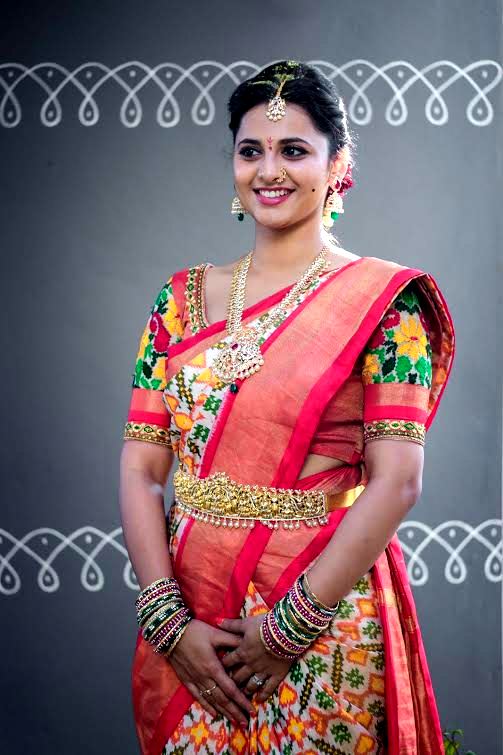
Here are some key details about Pochampally sarees, including their features and significance:
Ikat Technique: Pochampally sarees are created using the ikat weaving technique, which involves resist dyeing the threads before they are woven into fabric. This results in patterns that appear to be slightly blurred or softened, adding to the charm of the saree.
Patterns and Motifs: Pochampally sarees are known for their intricate geometric and floral patterns. These patterns are carefully designed and dyed onto the threads before weaving, creating a harmonious blend of colors and designs.
Color Palette: Pochampally sarees are characterized by their vibrant and rich color palette. The sarees often feature contrasting colors and bold combinations, making them visually striking.
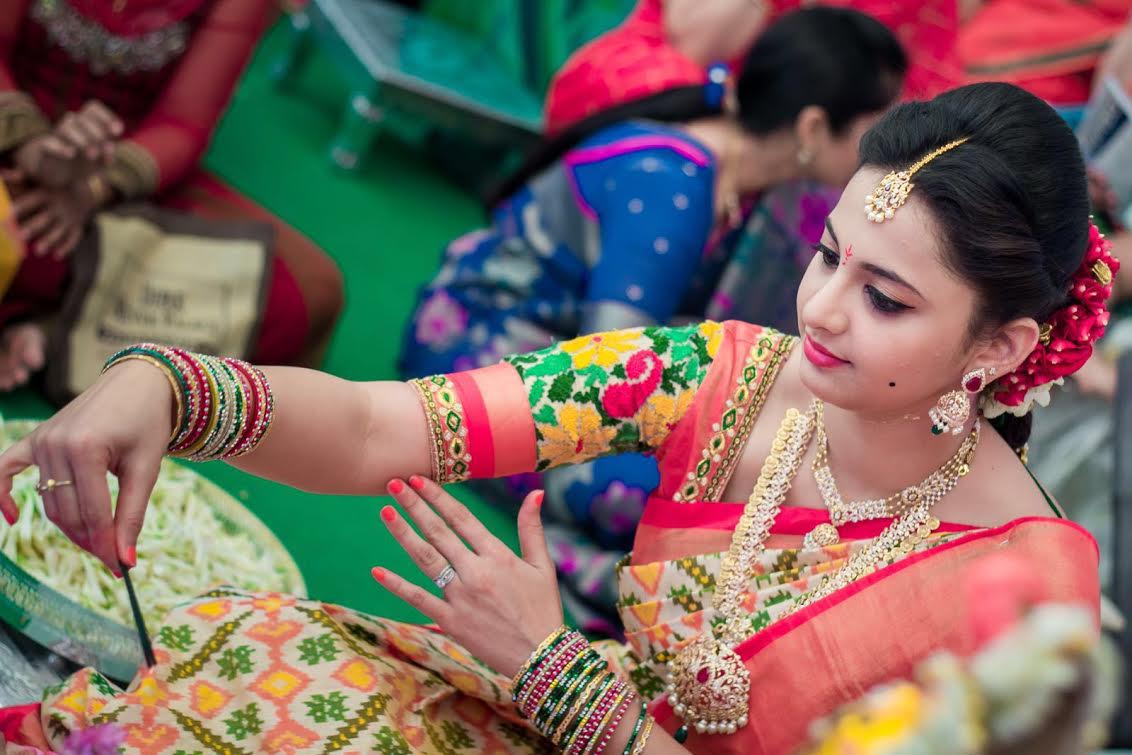
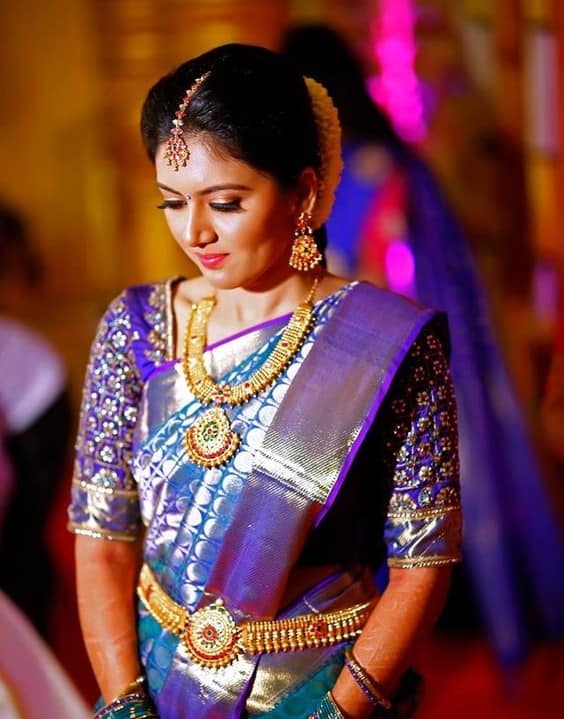
Fabric: Pochampally sarees are usually woven from silk, cotton, or a combination of both. The choice of fabric depends on the desired look and comfort of the saree.
Variety: Pochampally sarees come in various styles and designs, catering to different tastes and preferences. Some sarees may have intricate and densely woven patterns, while others might feature simpler and more understated designs.
Occasions: While Pochampally sarees are versatile and can be worn on various occasions, they are often chosen for weddings and festive celebrations due to their exquisite craftsmanship and vibrant appearance.
Accessories: Pochampally sarees can be paired with traditional jewelry and accessories, enhancing the overall look. Gold or silver jewelry complements the rich colors of the saree beautifully.
Popularity: Pochampally sarees have gained popularity among fashion enthusiasts and those seeking unique and handcrafted attire. They showcase the artistic skills of the weavers and reflect the cultural heritage of the region.
Handcrafted Artistry: Pochampally sarees are meticulously handwoven by skilled artisans who follow traditional techniques passed down through generations. The weaving process requires precision and expertise.
Global Recognition: Pochampally sarees have earned recognition on the global stage for their unique weaving technique and artistic value. They have been showcased at fashion events and exhibitions worldwide.
When selecting a Pochampally saree for a wedding, consider the color palette, design complexity, and your personal style. These sarees not only celebrate traditional craftsmanship but also make a statement with their bold and elegant designs.


